Paul van Yperen's Blog, page 358
January 12, 2016
Ruth Leuwerik (1924-2016)
Yesterday, actress Ruth Leuwerik passed away. In the 1950s she and co-star O.W. Fischer were Germany's favourite couple. The German box office queen played Maria in Die Trapp-Familie (1956), the original version of The Sound of Music. She was 91.
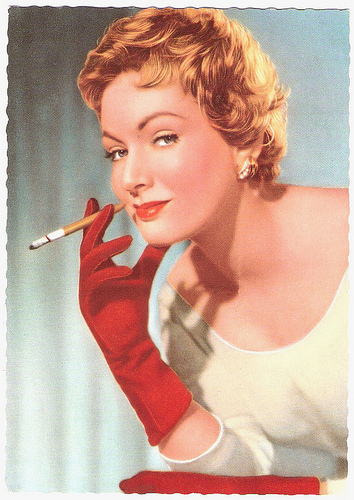
German postcard by Universum-Film Aktiengesellschaft, Berlin-Tempelhof (Ufa), no. CK 117. Retail price: 30 Pfg. Photo: Arthur Grimm.
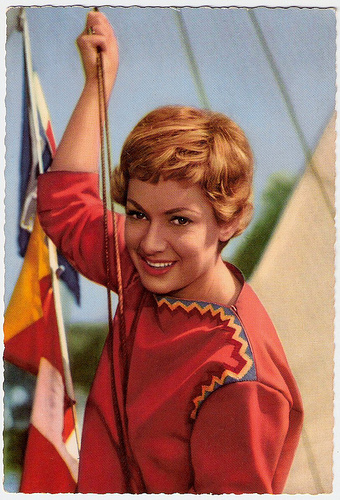
Belgian postcard by Edition H. Troukens, Hofstade. Photo: Ufa.
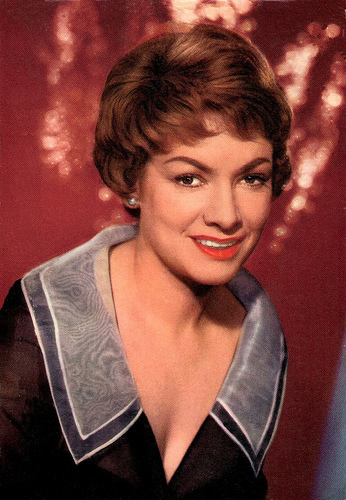
German postcard printed by ISV, no. H 49.
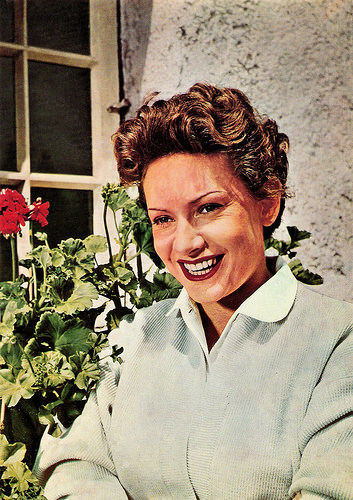
Big German postcard by WS-Druck, Wanne-Eickel, no. FP 4. Photo: Theo Huster.
Dieter Borsche
Ruth Leuwerik was born in Essen, Germany, in 1924. She made her stage debut during the war with the touring company of the Landestheaters Münster.
Her film career started with a supporting role in 13 unter einem Hut/13 Under a Hat (Johannes Meyer, 1950), but the film was not a hit.
When she was introduced to film actor Dieter Borsche , he made her his leading lady in Vater braucht eine Frau/Father Needs A Woman (Harald Braun, 1952).
The comedy became a surprise hit and the two leads immediately made another box office smash, Die große Versuchung/The Big Temptation (Rolf Hansen, 1952).
In 1953 she had her definitive breakthrough with four films. In the romantic melodrama Ein Herz spielt falsch/A Heart's Foul Play (Rudolf Jugert, 1953) she played for the first time with O.W. Fischer . They became the beloved Traumpaar (Dream couple) of the German public.
In Königliche Hoheit/His Royal Highness (Harald Braun, 1953) she was an American heiress raised in Europe, who falls in love with a handsome but shy German prince ( Dieter Borsche ). The story was adapted from a novel by Thomas Mann, who was pleased with the film version.
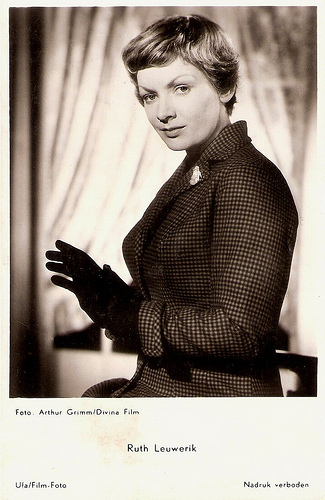
Dutch postcard by Gebr. Spanjersberg N.V., Rotterdam, no. 3331. Photo: Ufa / Arthur Grimm / Divina Film.
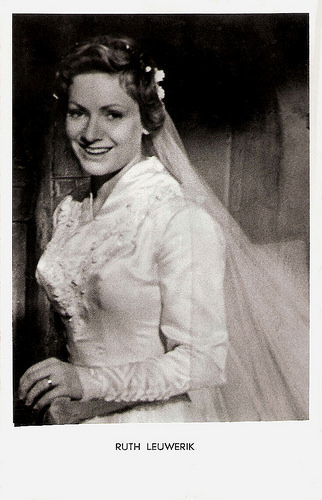
Dutch postcard, no. 63.
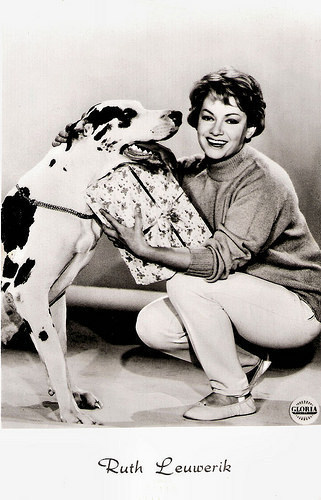
Dutch postcard, no. 5942. Photo: Gloria.
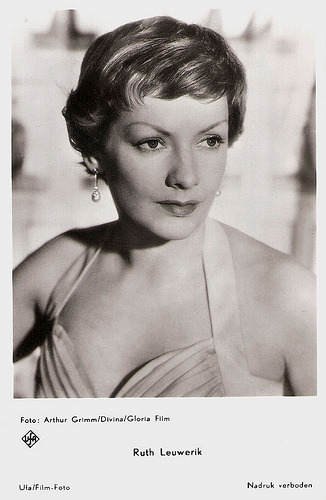
Dutch postcard by DRC Holland, no. 3015. Photo: Arthur Grimm / Divina / Gloria Film / Ufa.
Independent
Ruth Leuwerik played in many costume pictures, including Ludwig II/Mad Emperor: Ludwig II (Helmut Käutner, 1955) as Elisabeth of Austria with O.W. Fischer as her nephew Ludwig II, and Rosen im Herbst/Roses in the Autumn (Rudolf Jugert, 1955), based on Theodor Fontane’s Effi Briest. It seemed to become her trademark.
Her career was revitalized with Die Trapp-Familie/The Trapp Family ( Wolfgang Liebeneiner , 1956) and the sequel Die Trapp-Familie in Amerika/The Trapp Family in America (Wolfgang Liebeneiner, 1958) about the free spirited nun and nanny Maria who becomes Baroness Von Trapp.
At IMDb, Maurice de Saxe writes about Die Trapp-Familie: "Largely forgotten today, the pic holds up quite well. The story is not too exciting, there's nothing that might offend blue-noses and all takes place against an pastoral background of green meadows and snow-capped mountains. Ruth Leuwerik does what she can with the wafer-thin part and her warmth and natural beauty prevent the whole thing form being too syrupy."
Together with the box office success of the war camp drama Taiga (Wolfgang Liebeneiner, 1958) these films made her the most popular German film star of the late 1950s. She was beloved by female filmgoers, because of her independent, professionally successful characters.
In the 1960s her film popularity waned. The well-intended but somewhat muddled Die Rote/Redhead (Helmut Käutner, 1962) sealed her fate as box-office cyanide after a string of flops. But according to reviewer Jan de Witt at IMDb her performance in this film is "very subtle, giving the over-complicated story its little coherence."
After this film she started to work mainly for TV, including guest appearances in the Krimi series Derrick (1978-1983). Her last film was Unordnung und Fruehes Leid/Disorder And Early Torment (Frans Seitz, 1977) with Martin Held .
Among her many awards are the Filmband in Gold in 1974 and the Großen Verdienstkreuz der Bundesrepublik Deutschland (Germany's Cross of merit) in 1980.
Ruth Leuwerik died in Munich on 12 January 2016. She was married three times, to actor Herbert Fleischmann, singer-conductor Dietrich Fischer-Dieskau and to Dr. Heinz Purper.
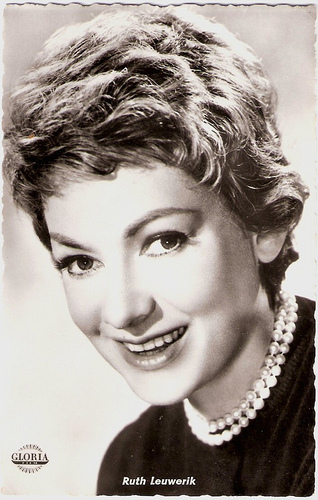
German postcard by Kolibri-Verlag G.m.b.H, Minden/Westf., no. 397. Photo: Weisse / Divina / Gloria.
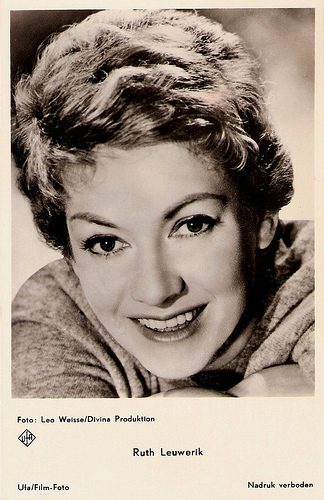
Dutch postcard by Gebr. Spanjersberg N.V., Rotterdam, no. 4262. Photo: Ufa/Film-Foto / Leo Weisse / Divina Film.
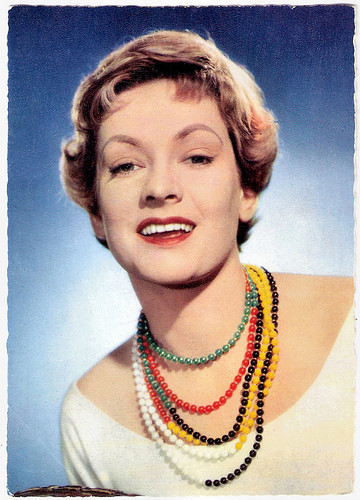
German postcard by Franz Josef Rüdel, Filmpostkartenverlag, Hamburg-Bergedorf, no. FT 33. Photo: CCC / Gloria / Grimm. Publicity still for Auf Wiedersehen, Franziska!/Goodbye, Franziska! (Wolfgang Liebeneiner, 1957).
Scene from Die Trapp-Familie/The Trapp Family (1956). Source: Melanie Zander (YouTube).
Sources: Stephanie D'heil (Steffi-line) (German), Maurice de Saxe (IMDb), Jan de Witt (IMDb), AllMovie, Wikipedia (German), and .

German postcard by Universum-Film Aktiengesellschaft, Berlin-Tempelhof (Ufa), no. CK 117. Retail price: 30 Pfg. Photo: Arthur Grimm.

Belgian postcard by Edition H. Troukens, Hofstade. Photo: Ufa.

German postcard printed by ISV, no. H 49.

Big German postcard by WS-Druck, Wanne-Eickel, no. FP 4. Photo: Theo Huster.
Dieter Borsche
Ruth Leuwerik was born in Essen, Germany, in 1924. She made her stage debut during the war with the touring company of the Landestheaters Münster.
Her film career started with a supporting role in 13 unter einem Hut/13 Under a Hat (Johannes Meyer, 1950), but the film was not a hit.
When she was introduced to film actor Dieter Borsche , he made her his leading lady in Vater braucht eine Frau/Father Needs A Woman (Harald Braun, 1952).
The comedy became a surprise hit and the two leads immediately made another box office smash, Die große Versuchung/The Big Temptation (Rolf Hansen, 1952).
In 1953 she had her definitive breakthrough with four films. In the romantic melodrama Ein Herz spielt falsch/A Heart's Foul Play (Rudolf Jugert, 1953) she played for the first time with O.W. Fischer . They became the beloved Traumpaar (Dream couple) of the German public.
In Königliche Hoheit/His Royal Highness (Harald Braun, 1953) she was an American heiress raised in Europe, who falls in love with a handsome but shy German prince ( Dieter Borsche ). The story was adapted from a novel by Thomas Mann, who was pleased with the film version.

Dutch postcard by Gebr. Spanjersberg N.V., Rotterdam, no. 3331. Photo: Ufa / Arthur Grimm / Divina Film.

Dutch postcard, no. 63.

Dutch postcard, no. 5942. Photo: Gloria.

Dutch postcard by DRC Holland, no. 3015. Photo: Arthur Grimm / Divina / Gloria Film / Ufa.
Independent
Ruth Leuwerik played in many costume pictures, including Ludwig II/Mad Emperor: Ludwig II (Helmut Käutner, 1955) as Elisabeth of Austria with O.W. Fischer as her nephew Ludwig II, and Rosen im Herbst/Roses in the Autumn (Rudolf Jugert, 1955), based on Theodor Fontane’s Effi Briest. It seemed to become her trademark.
Her career was revitalized with Die Trapp-Familie/The Trapp Family ( Wolfgang Liebeneiner , 1956) and the sequel Die Trapp-Familie in Amerika/The Trapp Family in America (Wolfgang Liebeneiner, 1958) about the free spirited nun and nanny Maria who becomes Baroness Von Trapp.
At IMDb, Maurice de Saxe writes about Die Trapp-Familie: "Largely forgotten today, the pic holds up quite well. The story is not too exciting, there's nothing that might offend blue-noses and all takes place against an pastoral background of green meadows and snow-capped mountains. Ruth Leuwerik does what she can with the wafer-thin part and her warmth and natural beauty prevent the whole thing form being too syrupy."
Together with the box office success of the war camp drama Taiga (Wolfgang Liebeneiner, 1958) these films made her the most popular German film star of the late 1950s. She was beloved by female filmgoers, because of her independent, professionally successful characters.
In the 1960s her film popularity waned. The well-intended but somewhat muddled Die Rote/Redhead (Helmut Käutner, 1962) sealed her fate as box-office cyanide after a string of flops. But according to reviewer Jan de Witt at IMDb her performance in this film is "very subtle, giving the over-complicated story its little coherence."
After this film she started to work mainly for TV, including guest appearances in the Krimi series Derrick (1978-1983). Her last film was Unordnung und Fruehes Leid/Disorder And Early Torment (Frans Seitz, 1977) with Martin Held .
Among her many awards are the Filmband in Gold in 1974 and the Großen Verdienstkreuz der Bundesrepublik Deutschland (Germany's Cross of merit) in 1980.
Ruth Leuwerik died in Munich on 12 January 2016. She was married three times, to actor Herbert Fleischmann, singer-conductor Dietrich Fischer-Dieskau and to Dr. Heinz Purper.

German postcard by Kolibri-Verlag G.m.b.H, Minden/Westf., no. 397. Photo: Weisse / Divina / Gloria.

Dutch postcard by Gebr. Spanjersberg N.V., Rotterdam, no. 4262. Photo: Ufa/Film-Foto / Leo Weisse / Divina Film.

German postcard by Franz Josef Rüdel, Filmpostkartenverlag, Hamburg-Bergedorf, no. FT 33. Photo: CCC / Gloria / Grimm. Publicity still for Auf Wiedersehen, Franziska!/Goodbye, Franziska! (Wolfgang Liebeneiner, 1957).
Scene from Die Trapp-Familie/The Trapp Family (1956). Source: Melanie Zander (YouTube).
Sources: Stephanie D'heil (Steffi-line) (German), Maurice de Saxe (IMDb), Jan de Witt (IMDb), AllMovie, Wikipedia (German), and .
Published on January 12, 2016 22:00
January 11, 2016
David Bowie (1947-2016)
What a shock! David Bowie is dead. The English musician and actor was a major pop star for over four decades. During the 1970s, he was a magnificent innovator, we love his album Changes. With various stage and film roles, he showed to be a fine actor too. Bowie died of cancer, 69 years young.
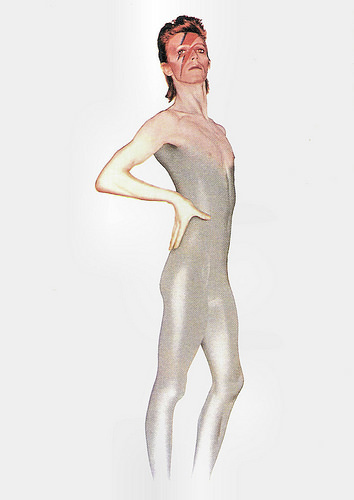
British postcard by Underground, no. U525. Ziggie.
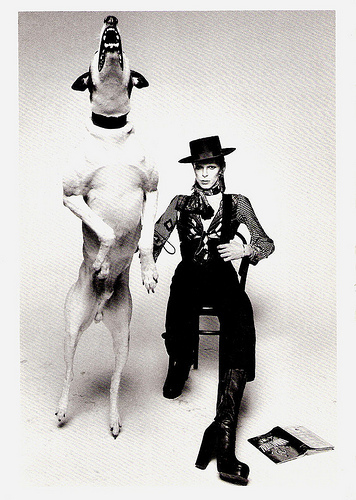
American postcard by Fotofolio, no. P 254. Photo: Terry O'Neill, 1975.
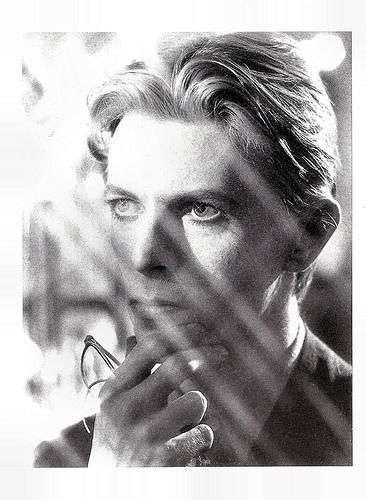
British postcard in the British Film Year Series. Photo: David James / Thorn EMI. Publicity still for The Man who Fell to the Earth (Nicolas Roeg, 1976).
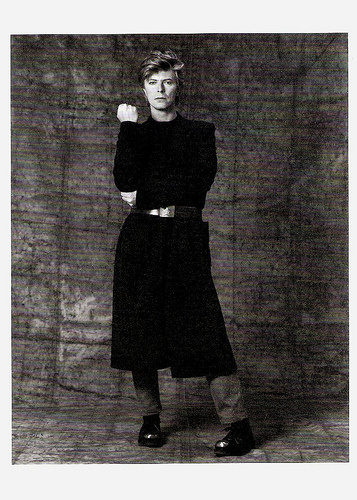
American postcard by Fotofolio, New York, NY., no. GG 21. Photo: Greg Gorman, 1987.

Dutch postcard by Art Unlimited, Amsterdam, no. 010a. Photo: Claude Vanheye.
Flamboyant, Androgynous Alter Ego
David Bowie was born as David Robert Haywood Jones in Brixton, London in 1947. His mother, Margaret Mary ‘Peggy’ née Burns, worked as a cinema usherette, while his father, Haywood Stenton ‘John’ Jones, was a promotions officer for Barnardo's. David's interest in music was stimulated when his father brought home a collection of American 45’s by artists including The Platters, Fats Domino, Elvis Presley and Little Richard. He studied art, music, and design, including layout and typesetting. After Terry Burns, his half-brother, introduced him to modern jazz, his enthusiasm for players like Charles Mingus and John Coltrane led his mother to give him a plastic alto saxophone in 1961.
A year later, the 15-years old Davy Jones formed his first band The Konrads, playing guitar-based rock & roll at local youth gatherings and weddings. Several bands followed, without success. To prevent confusion with Davy Jones, the lead singer of The Monkees, he renamed himself after the 19th century American frontiersman Jim Bowie and the knife he had popularised. David Bowie studied dramatic arts under dancer Lindsay Kemp, from avant-garde theatre and mime to commedia dell'arte. Bowie became immersed in the creation of personae to present to the world. Kemp gave him the role of Cloud in his theatrical production Pierrot in Turquoise (1967).
In the black-and-white short The Image (Michael Armstrong, 1969), Bowie played a ghostly boy who emerges from a troubled artist's (Michael Byrne) painting to haunt him. Bowie also made a brief appearance in The Virgin Soldiers (John Dexter, 1969). In April 1969, he met Angela Barnett (also known as Angie Bowie) and they would marry within a year. Her impact on him was immediate, and her involvement in his career far-reaching. In 1971, they had a son, later film director Duncan Jones, also known as Zowie Bowie.
David Bowie first caught the eye and ear of the public in July 1969, when his song Space Oddity reached the top five of the UK Singles Chart. It was released at the time of the moon landing. Despite the fact that the literal meaning of the lyrics relates to an astronaut who is lost in space, this song was used by the BBC in their coverage of the moon landing, and this helped it become such a success. After a three-year period of experimentation he re-emerged in 1972 during the glam rock era with the flamboyant, androgynous alter ego Ziggy Stardust, spearheaded by the hit single Starman and the album The Rise and Fall of Ziggy Stardust and the Spiders from Mars, a concept album about a space-age rock star.
The relatively short-lived Ziggy persona proved merely one facet of a career marked by continual reinvention, musical innovation and striking visual presentation. In 1975, Bowie achieved his first major American crossover success with the number-one single Fame and the hit album Young Americans, which the singer characterised as ‘plastic soul’. The sound constituted a radical shift in style that initially alienated many of his UK devotees. He then confounded the expectations of both his record label and his American audiences by recording the minimalist album Low (1977) — the first of three collaborations with Brian Eno over the next two years. The so-called Berlin Trilogy albums (Low, Heroes and Lodger) all reached the UK top five and received lasting critical praise.

British postcard by Cult Images Ltd., Enfield, Middlesex, no. PC 108. Photo: Ray Stevenson. Beckenham '69.

French postcard by Ebullitions, no. 8.
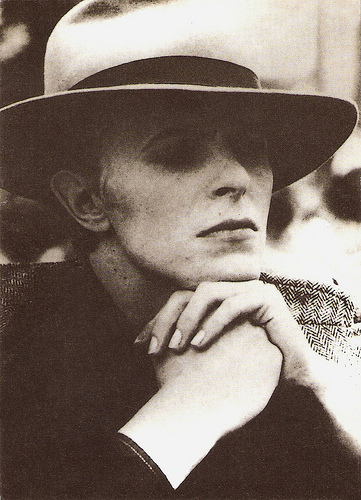
German postcard by O & P Agi-Sydney, Stauffenberg, no. CP 770.
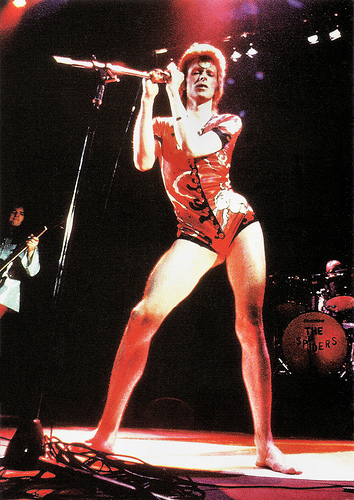
British postcard by Pyramid, Leicester, no. PC 8030. Photo: Bowie as Ziggie Stardust, live.
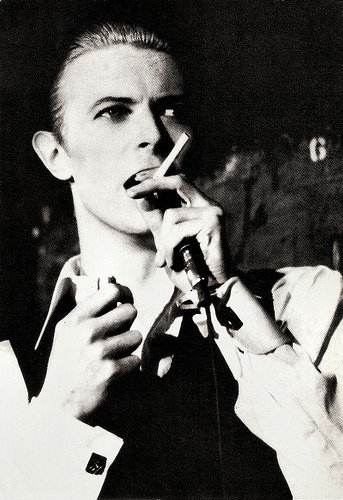
French postcard by Humour à la Carte, Paris, no. 3401. Photo: J.L. Rancurel. David Bowie at the Pavillon de Paris, 1976.
Gigolo
In 1976 David Bowie earned acclaim for his first major film role. In The Man Who Fell to Earth (Nicolas Roeg, 1976) he played an unhappy alien from a dying planet who becomes a famous industrialist and pop star as he tries to find a way home. Mark Deming at AllMovie : “While Bowie doesn't come off as a terribly skilled actor, he's highly effective as an alien presence (and his character's jittery paranoia got an unexpected boost from Bowie's well-documented cocaine abuse in this period), and he manages to radiate a human sense of sadness and loss while maintaining a cold, unearthly emotional distance.”
His performance helped the film become a modest box-office success. His next film, the Anglo-German co-production Schöner Gigolo, Armer Gigolo/Just a Gigolo (David Hemmings, 1979), saw Bowie in the lead role as Prussian officer Paul von Przygodski, who, returning from World War I, is discovered by a Baroness ( Marlene Dietrich in her final screen performance) and put into her gigolo stable. However the critics were negative and the Sunday Mirror considered Bowie ‘completely miscast’.
In this period, his commercial success as a recording artist was also uneven. Towards the end of the 1970s, Bowie finally kicked his drug habit and had smash hits with the single Ashes to Ashes (1980), its parent album Scary Monsters (and Super Creeps), and the single Under Pressure (1981), a collaboration with Queen. On Broadway he earned high praise for his expressive performance in The Elephant Man. He played the part 157 times between 1980 and 1981.
Bowie did a cameo performance as himself in a concert sequence in the German film Christiane F. – Wir Kinder vom Bahnhof Zoo (Ulrich Edel, 1981). The soundtrack of the film about a young girl's drug addiction in West-Berlin featured much material from his Berlin Trilogy albums. Bowie then starred as a vampire in The Hunger (Tony Scott, 1983), with Catherine Deneuve .
That same year, he played Major Jack Celliers, a prisoner of war in a Japanese internment camp in Merry Christmas, Mr. Lawrence (Nagisa Oshima, 1983), based on Laurens van der Post's novel The Seed and the Sower. Bowie also had a cameo in the pirate comedy Yellowbeard (Mel Damski, 1983) created by Monty Python members. In 1983, he also reached a new commercial peak with the album Let's Dance, which yielded several hit singles. The tour which followed, Serious Moonlight, was his most successful ever.
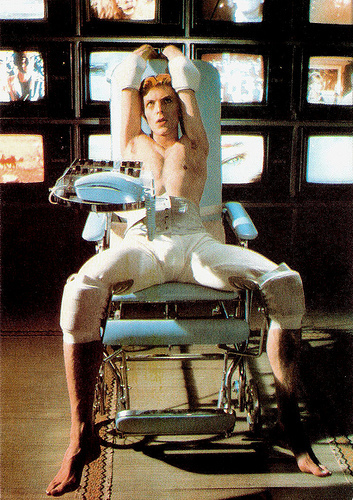
French postcard by Underground, no. U 182. Photo: publicity still for The Man Who Fell to Earth (1976).
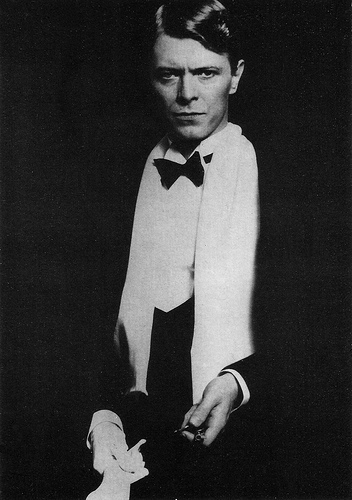
French postcard by Euro Images, St. Jean de Veudas, no. CP 57. Photo: publicity still for Schöner Gigolo, armer Gigolo/Just a Gigolo (David Hemmings, 1978).
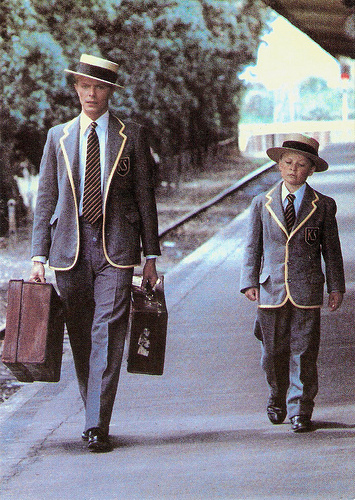
French Postcard by Les Editions Gil in the série chanteurs, no. 76. Publicity still for Merry Christmas, Mr. Lawrence (1983).
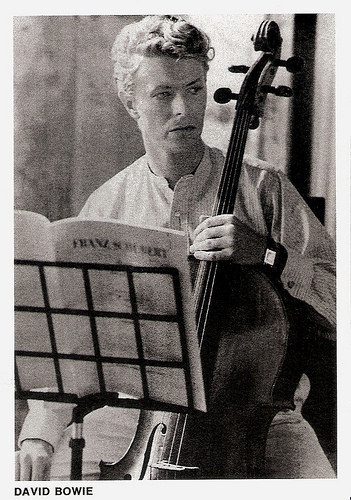
British postcard. Photo: publicity still for The Hunger (Tony Scott, 1983).
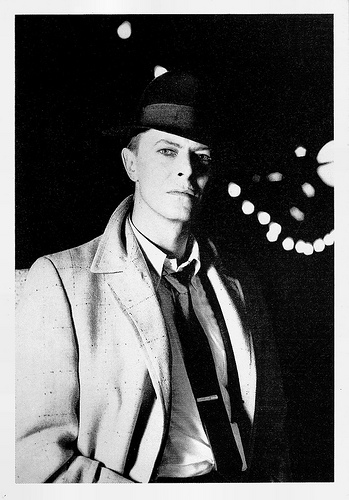
French postcard by Editions Humour à la Carte, Paris, no. ST-127. Photo: publicity still for Absolute Beginners (Julien Temple, 1986).
The Next Day
David Bowie declined to play the villain Max Zorin in the James Bond film A View to a Kill (John Glen, 1985), but accepted a small part as Colin, the hitman in the comedy-thriller Into the Night (John Landis, 1985). He also played a small part in Absolute Beginners (Julien Temple, 1986), a rock musical featuring Bowie's music.
About his role as the Goblin King in the dark fantasy Labyrinth (Jim Henson, 1986), Andrea LeVasseur writes at AllMovie: “The actor most notable is David Bowie as the villain Jareth, whose glam rock wig and revealing tights give a nod to his former alter ego Ziggy Stardust. He is quite possibly the high point of the film, contributing to songwriting and creating an alluring figure in Jareth that rightfully could be borne of a young girl's imagination.” Two years later he played Pontius Pilate in the controversial The Last Temptation of Christ (Martin Scorsese, 1988).
Throughout the 1990s and 2000s, David Bowie continued to experiment with musical styles, including blue-eyed soul, industrial, adult contemporary, and jungle. He also continued to act in films. He portrayed a disgruntled restaurant employee opposite Rosanna Arquette in The Linguini Incident (Richard Shephard, 1991), and the mysterious FBI agent Phillip Jeffries in Twin Peaks: Fire Walk with Me (David Lynch, 1992). He took a small but pivotal role as Andy Warhol in the biopic Basquiat (Julian Schnabel, 1996), and co-starred in the spaghetti western Il Mio West/Gunslinger's Revenge (Giovanni Veronesi, 1998) as the most feared gunfighter in the region.
Bowie played the ageing gangster Bernie in Everybody Loves Sunshine (Andrew Goth, 1999), and appeared in the TV horror serial of The Hunger. In Mr. Rice's Secret (2000), he played the title role as the neighbour of a terminally ill twelve-year-old, and appeared as himself in Zoolander (Ben Stiller, 2001). He portrayed physicist Nikola Tesla in The Prestige (Christopher Nolan, 2006), about the bitter rivalry between two magicians (Hugh Jackman and Christian Bale) in the late 19th century. In August (Austin Chick, 2008), he played a supporting role as Ogilvie, alongside Josh Hartnett.
Bowie did not tour since the 2003–2004 Reality Tour and did not perform live since 2006. In 2013, he returned with the studio album The Next Day — his first in ten years. The album was produced by Bowie's longtime collaborator Tony Visconti. The music video of the track The Stars (Are Out Tonight) starred Tilda Swinton as Bowie's wife, and also featured young models Saskia de Brauw, Andrej Pejic, and Iselin Steiro. Tim Blanks at Style File Blog : "This particular offering toys with the androgyny, the bravado, the decadence, the desire that turns an ordinary human being into a raving fan. " The video was directed by Floria Sigismondi, who was also behind the videos for Bowie's Little Wonder (1996) and Dead Man Walking (1997).
On 8 January 2016, the date of David Bowie's 69th birthday, his final studio album Blackstar was released; he died two days later. Throughout his career, Bowie has sold an estimated 140 million albums. In 2004, Rolling Stone ranked him 39th on their list of the ‘100 Greatest Artists of All Time’, and 23rd on their list of the best singers of all time. Since 1992 Bowie was married to Somali-American model Iman. They had one daughter, Alexandria Zahra Jones (2000).
Official video for David Bowie Space Oddity. Source: David Bowie (YouTube).
Trailer The Man Who Fell to Earth (1976). Source: LionsgateVOD (YouTube).
Trailer Merry Christmas, Mr. Lawrence (1983). Source: kasoooo (YouTube).
Trailer The Hunger (1983). Source: 28march2008 (YouTube).
Trailer Labyrinth (1986). Source: SonyPicsHomeEntWorld (YouTube).
Sources: Mark Deming (AllMovie), Andrea LeVasseur (AllMovie) , (IMDb), Tim Blanks (Style File Blog), AllMovie, Wikipedia, and .

British postcard by Underground, no. U525. Ziggie.

American postcard by Fotofolio, no. P 254. Photo: Terry O'Neill, 1975.

British postcard in the British Film Year Series. Photo: David James / Thorn EMI. Publicity still for The Man who Fell to the Earth (Nicolas Roeg, 1976).

American postcard by Fotofolio, New York, NY., no. GG 21. Photo: Greg Gorman, 1987.

Dutch postcard by Art Unlimited, Amsterdam, no. 010a. Photo: Claude Vanheye.
Flamboyant, Androgynous Alter Ego
David Bowie was born as David Robert Haywood Jones in Brixton, London in 1947. His mother, Margaret Mary ‘Peggy’ née Burns, worked as a cinema usherette, while his father, Haywood Stenton ‘John’ Jones, was a promotions officer for Barnardo's. David's interest in music was stimulated when his father brought home a collection of American 45’s by artists including The Platters, Fats Domino, Elvis Presley and Little Richard. He studied art, music, and design, including layout and typesetting. After Terry Burns, his half-brother, introduced him to modern jazz, his enthusiasm for players like Charles Mingus and John Coltrane led his mother to give him a plastic alto saxophone in 1961.
A year later, the 15-years old Davy Jones formed his first band The Konrads, playing guitar-based rock & roll at local youth gatherings and weddings. Several bands followed, without success. To prevent confusion with Davy Jones, the lead singer of The Monkees, he renamed himself after the 19th century American frontiersman Jim Bowie and the knife he had popularised. David Bowie studied dramatic arts under dancer Lindsay Kemp, from avant-garde theatre and mime to commedia dell'arte. Bowie became immersed in the creation of personae to present to the world. Kemp gave him the role of Cloud in his theatrical production Pierrot in Turquoise (1967).
In the black-and-white short The Image (Michael Armstrong, 1969), Bowie played a ghostly boy who emerges from a troubled artist's (Michael Byrne) painting to haunt him. Bowie also made a brief appearance in The Virgin Soldiers (John Dexter, 1969). In April 1969, he met Angela Barnett (also known as Angie Bowie) and they would marry within a year. Her impact on him was immediate, and her involvement in his career far-reaching. In 1971, they had a son, later film director Duncan Jones, also known as Zowie Bowie.
David Bowie first caught the eye and ear of the public in July 1969, when his song Space Oddity reached the top five of the UK Singles Chart. It was released at the time of the moon landing. Despite the fact that the literal meaning of the lyrics relates to an astronaut who is lost in space, this song was used by the BBC in their coverage of the moon landing, and this helped it become such a success. After a three-year period of experimentation he re-emerged in 1972 during the glam rock era with the flamboyant, androgynous alter ego Ziggy Stardust, spearheaded by the hit single Starman and the album The Rise and Fall of Ziggy Stardust and the Spiders from Mars, a concept album about a space-age rock star.
The relatively short-lived Ziggy persona proved merely one facet of a career marked by continual reinvention, musical innovation and striking visual presentation. In 1975, Bowie achieved his first major American crossover success with the number-one single Fame and the hit album Young Americans, which the singer characterised as ‘plastic soul’. The sound constituted a radical shift in style that initially alienated many of his UK devotees. He then confounded the expectations of both his record label and his American audiences by recording the minimalist album Low (1977) — the first of three collaborations with Brian Eno over the next two years. The so-called Berlin Trilogy albums (Low, Heroes and Lodger) all reached the UK top five and received lasting critical praise.

British postcard by Cult Images Ltd., Enfield, Middlesex, no. PC 108. Photo: Ray Stevenson. Beckenham '69.

French postcard by Ebullitions, no. 8.

German postcard by O & P Agi-Sydney, Stauffenberg, no. CP 770.

British postcard by Pyramid, Leicester, no. PC 8030. Photo: Bowie as Ziggie Stardust, live.

French postcard by Humour à la Carte, Paris, no. 3401. Photo: J.L. Rancurel. David Bowie at the Pavillon de Paris, 1976.
Gigolo
In 1976 David Bowie earned acclaim for his first major film role. In The Man Who Fell to Earth (Nicolas Roeg, 1976) he played an unhappy alien from a dying planet who becomes a famous industrialist and pop star as he tries to find a way home. Mark Deming at AllMovie : “While Bowie doesn't come off as a terribly skilled actor, he's highly effective as an alien presence (and his character's jittery paranoia got an unexpected boost from Bowie's well-documented cocaine abuse in this period), and he manages to radiate a human sense of sadness and loss while maintaining a cold, unearthly emotional distance.”
His performance helped the film become a modest box-office success. His next film, the Anglo-German co-production Schöner Gigolo, Armer Gigolo/Just a Gigolo (David Hemmings, 1979), saw Bowie in the lead role as Prussian officer Paul von Przygodski, who, returning from World War I, is discovered by a Baroness ( Marlene Dietrich in her final screen performance) and put into her gigolo stable. However the critics were negative and the Sunday Mirror considered Bowie ‘completely miscast’.
In this period, his commercial success as a recording artist was also uneven. Towards the end of the 1970s, Bowie finally kicked his drug habit and had smash hits with the single Ashes to Ashes (1980), its parent album Scary Monsters (and Super Creeps), and the single Under Pressure (1981), a collaboration with Queen. On Broadway he earned high praise for his expressive performance in The Elephant Man. He played the part 157 times between 1980 and 1981.
Bowie did a cameo performance as himself in a concert sequence in the German film Christiane F. – Wir Kinder vom Bahnhof Zoo (Ulrich Edel, 1981). The soundtrack of the film about a young girl's drug addiction in West-Berlin featured much material from his Berlin Trilogy albums. Bowie then starred as a vampire in The Hunger (Tony Scott, 1983), with Catherine Deneuve .
That same year, he played Major Jack Celliers, a prisoner of war in a Japanese internment camp in Merry Christmas, Mr. Lawrence (Nagisa Oshima, 1983), based on Laurens van der Post's novel The Seed and the Sower. Bowie also had a cameo in the pirate comedy Yellowbeard (Mel Damski, 1983) created by Monty Python members. In 1983, he also reached a new commercial peak with the album Let's Dance, which yielded several hit singles. The tour which followed, Serious Moonlight, was his most successful ever.

French postcard by Underground, no. U 182. Photo: publicity still for The Man Who Fell to Earth (1976).

French postcard by Euro Images, St. Jean de Veudas, no. CP 57. Photo: publicity still for Schöner Gigolo, armer Gigolo/Just a Gigolo (David Hemmings, 1978).

French Postcard by Les Editions Gil in the série chanteurs, no. 76. Publicity still for Merry Christmas, Mr. Lawrence (1983).

British postcard. Photo: publicity still for The Hunger (Tony Scott, 1983).

French postcard by Editions Humour à la Carte, Paris, no. ST-127. Photo: publicity still for Absolute Beginners (Julien Temple, 1986).
The Next Day
David Bowie declined to play the villain Max Zorin in the James Bond film A View to a Kill (John Glen, 1985), but accepted a small part as Colin, the hitman in the comedy-thriller Into the Night (John Landis, 1985). He also played a small part in Absolute Beginners (Julien Temple, 1986), a rock musical featuring Bowie's music.
About his role as the Goblin King in the dark fantasy Labyrinth (Jim Henson, 1986), Andrea LeVasseur writes at AllMovie: “The actor most notable is David Bowie as the villain Jareth, whose glam rock wig and revealing tights give a nod to his former alter ego Ziggy Stardust. He is quite possibly the high point of the film, contributing to songwriting and creating an alluring figure in Jareth that rightfully could be borne of a young girl's imagination.” Two years later he played Pontius Pilate in the controversial The Last Temptation of Christ (Martin Scorsese, 1988).
Throughout the 1990s and 2000s, David Bowie continued to experiment with musical styles, including blue-eyed soul, industrial, adult contemporary, and jungle. He also continued to act in films. He portrayed a disgruntled restaurant employee opposite Rosanna Arquette in The Linguini Incident (Richard Shephard, 1991), and the mysterious FBI agent Phillip Jeffries in Twin Peaks: Fire Walk with Me (David Lynch, 1992). He took a small but pivotal role as Andy Warhol in the biopic Basquiat (Julian Schnabel, 1996), and co-starred in the spaghetti western Il Mio West/Gunslinger's Revenge (Giovanni Veronesi, 1998) as the most feared gunfighter in the region.
Bowie played the ageing gangster Bernie in Everybody Loves Sunshine (Andrew Goth, 1999), and appeared in the TV horror serial of The Hunger. In Mr. Rice's Secret (2000), he played the title role as the neighbour of a terminally ill twelve-year-old, and appeared as himself in Zoolander (Ben Stiller, 2001). He portrayed physicist Nikola Tesla in The Prestige (Christopher Nolan, 2006), about the bitter rivalry between two magicians (Hugh Jackman and Christian Bale) in the late 19th century. In August (Austin Chick, 2008), he played a supporting role as Ogilvie, alongside Josh Hartnett.
Bowie did not tour since the 2003–2004 Reality Tour and did not perform live since 2006. In 2013, he returned with the studio album The Next Day — his first in ten years. The album was produced by Bowie's longtime collaborator Tony Visconti. The music video of the track The Stars (Are Out Tonight) starred Tilda Swinton as Bowie's wife, and also featured young models Saskia de Brauw, Andrej Pejic, and Iselin Steiro. Tim Blanks at Style File Blog : "This particular offering toys with the androgyny, the bravado, the decadence, the desire that turns an ordinary human being into a raving fan. " The video was directed by Floria Sigismondi, who was also behind the videos for Bowie's Little Wonder (1996) and Dead Man Walking (1997).
On 8 January 2016, the date of David Bowie's 69th birthday, his final studio album Blackstar was released; he died two days later. Throughout his career, Bowie has sold an estimated 140 million albums. In 2004, Rolling Stone ranked him 39th on their list of the ‘100 Greatest Artists of All Time’, and 23rd on their list of the best singers of all time. Since 1992 Bowie was married to Somali-American model Iman. They had one daughter, Alexandria Zahra Jones (2000).
Official video for David Bowie Space Oddity. Source: David Bowie (YouTube).
Trailer The Man Who Fell to Earth (1976). Source: LionsgateVOD (YouTube).
Trailer Merry Christmas, Mr. Lawrence (1983). Source: kasoooo (YouTube).
Trailer The Hunger (1983). Source: 28march2008 (YouTube).
Trailer Labyrinth (1986). Source: SonyPicsHomeEntWorld (YouTube).
Sources: Mark Deming (AllMovie), Andrea LeVasseur (AllMovie) , (IMDb), Tim Blanks (Style File Blog), AllMovie, Wikipedia, and .
Published on January 11, 2016 16:00
January 10, 2016
Maria Widal
Maria Widal started her career in the silent Danish cinema, credited as Luzzy Werren. In 1916, director Urban Gad built her up as a star for the German cinema and he directed nearly all her German films. She made her last film in 1920.

German postcard by Photochemie, Berlin, no. K. 2859. Photo: Saturnfilm.
Luzzy Werren
According to Den Danske Film Database, Maria Widal was a German actress, but nor her birth place nor her birth date are known.
In 1914, she started her career as a film actress in Denmark, where she made 17 silent films. In Danmark she was known as Luzzy Werne or Luzzy Werren.
She made her film debut with a small role as an adventurer in Under Vampyrens Kløer/In the claws of the vampire (1914). She also appeared in the Danish comedy Man skal ikke skue Hunden paa Haarene (Sofus Wolder, 1914) for the Nordisk Film Kompagni.
For Nordisk, she also made the comedies Min Ven Levy/My Friend Levy (Holger Madsen, 1914), and Endelig alene/Finally alone (Holger Madsen, 1914), both with Carl Schenstrom, later part of the famous comedy duo Fy og Bi or Pat & Patachon.
The following years, she made with director Aage Brandt such dramas as Skyldig - ikke skyldig/Guilty - not guilty (Aage Brandt, 1915) and Karfunkeldronningen/Carbuncle Queen (Aage Brandt, 1916) for the Filmfabrikken Skandinavien.
For Nordisk, she appeared with Valdemar Psilander in Det stjaalne ansigt/The Solen Face (Holger Madsen, 1916).
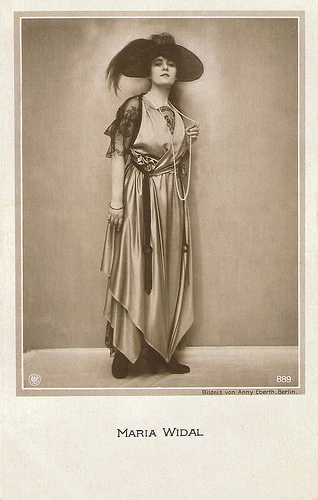
German postcard by NPG, no. 889. Photo: Anny Eberth, Berlin.
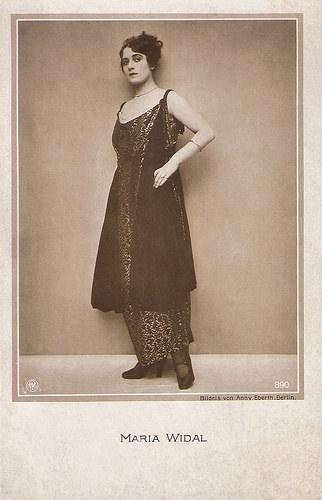
German postcard by NPG, no. 890. Photo: Anny Eberth, Berlin.
Urban Gad
In 1916, actress Maria Widal was built up by director Urban Gad as a new film star for the German cinema.
She made her German film debut for Saturn-Film in the German-Danish coproduction Der rote Streifen/The red stripe (Urban Gad, 1916) with Ernst Hofmann .
In the next years followed many other productions for Saturn-Film, including Die verschlossene Tür/The locked door (Urban Gad, 1917) with Albert Paul, Vera Panina (Urban Gad, 1918), and Der Schmuck des Rajah/The jewellery of the Rajah (Urban Gad, 1918).
After World War I, Widal starred in Irenes Fehltritt/Irene's misstep (Fritz Bernhardt, 1919) and Im Rausche der Sinne/In the poisoning of the senses (Ernst Sachs, 1919).
In 1920, Maria Widal already made her last films, Das Lied der Tränen/The Song of Tears (Fritz Bernhardt, 1920) and Graf Festenberg/Count Festenberg (1922) directed by Friedrich Zelnik and starring Charles Willy Kayser.
We could not find more information about Maria Widal. Any suggestions?
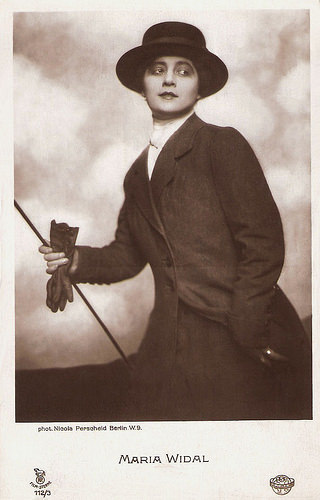
German postcard by Rotophot in the Film Sterne series, no. 112/3. Photo: Nicola Perscheid, Berlin.
Sources: Thomas Staedeli (Cyranos), Den danske film database (Danish) and .

German postcard by Photochemie, Berlin, no. K. 2859. Photo: Saturnfilm.
Luzzy Werren
According to Den Danske Film Database, Maria Widal was a German actress, but nor her birth place nor her birth date are known.
In 1914, she started her career as a film actress in Denmark, where she made 17 silent films. In Danmark she was known as Luzzy Werne or Luzzy Werren.
She made her film debut with a small role as an adventurer in Under Vampyrens Kløer/In the claws of the vampire (1914). She also appeared in the Danish comedy Man skal ikke skue Hunden paa Haarene (Sofus Wolder, 1914) for the Nordisk Film Kompagni.
For Nordisk, she also made the comedies Min Ven Levy/My Friend Levy (Holger Madsen, 1914), and Endelig alene/Finally alone (Holger Madsen, 1914), both with Carl Schenstrom, later part of the famous comedy duo Fy og Bi or Pat & Patachon.
The following years, she made with director Aage Brandt such dramas as Skyldig - ikke skyldig/Guilty - not guilty (Aage Brandt, 1915) and Karfunkeldronningen/Carbuncle Queen (Aage Brandt, 1916) for the Filmfabrikken Skandinavien.
For Nordisk, she appeared with Valdemar Psilander in Det stjaalne ansigt/The Solen Face (Holger Madsen, 1916).

German postcard by NPG, no. 889. Photo: Anny Eberth, Berlin.

German postcard by NPG, no. 890. Photo: Anny Eberth, Berlin.
Urban Gad
In 1916, actress Maria Widal was built up by director Urban Gad as a new film star for the German cinema.
She made her German film debut for Saturn-Film in the German-Danish coproduction Der rote Streifen/The red stripe (Urban Gad, 1916) with Ernst Hofmann .
In the next years followed many other productions for Saturn-Film, including Die verschlossene Tür/The locked door (Urban Gad, 1917) with Albert Paul, Vera Panina (Urban Gad, 1918), and Der Schmuck des Rajah/The jewellery of the Rajah (Urban Gad, 1918).
After World War I, Widal starred in Irenes Fehltritt/Irene's misstep (Fritz Bernhardt, 1919) and Im Rausche der Sinne/In the poisoning of the senses (Ernst Sachs, 1919).
In 1920, Maria Widal already made her last films, Das Lied der Tränen/The Song of Tears (Fritz Bernhardt, 1920) and Graf Festenberg/Count Festenberg (1922) directed by Friedrich Zelnik and starring Charles Willy Kayser.
We could not find more information about Maria Widal. Any suggestions?

German postcard by Rotophot in the Film Sterne series, no. 112/3. Photo: Nicola Perscheid, Berlin.
Sources: Thomas Staedeli (Cyranos), Den danske film database (Danish) and .
Published on January 10, 2016 22:00
January 9, 2016
Jaecki Schwarz
As a student, Jaecki Schwarz (1946) had his breakthrough with his lead role in the war film Ich war neunzehn/I was nineteen (Konrad Wolf, 1968). With his non-conventional acting style and his dry humour, he became a popular actor in dozens of DEFA films and East-German TV productions.
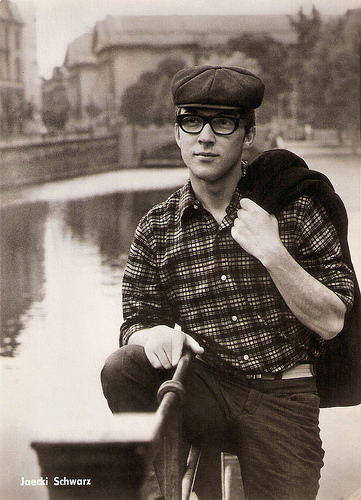
East-German card by VEB Progress Filmvertrieb, Berlin, no. 3297, 1968. Photo: Uhlenhut.
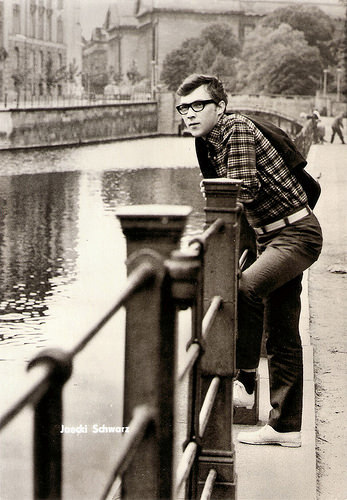
East-German card by VEB Progress Filmvertrieb, Berlin, no. 134/69, 1969. Photo: Uhlenhut.
I was nineteen
Jaecki Schwarz was born in Berlin in 1946. He attended the Alexander von Humboldt high school in Berlin, and completed an apprenticeship as a photo chemical technician. Then he applied twice at various drama schools, but after the aptitude test he was rejected. On the third try he succeeded and between 1965 and 1969, he studied at the Konrad Wolf Academy of Film and Television in Potsdam-Babelsberg.
Still a student, he became famous when he starred in the DEFA film Ich war neunzehn/I was nineteen (Konrad Wolf, 1968). In this film, Schwarz plays a young German, Gregor Hecker, who when he was eight fled the Nazis with his parents to Moscow. In early 1945, he returns to Germany as a lieutenant in the Red Army and is confronted with the dilemma of having to fight men from the very country he was born in. The film depicts the personal experiences of the director Konrad Wolf and of his friend Vladimir Gall in fictionalised form and deals with themes of the meaning of ‘homeland’.
William Shackleford at IMDb : “The intent of the movie, made in the GDR at a time when they were barraged with propaganda trying to make them believe that Russians were their friends, is obvious. Nevertheless, I did enjoy watching it, because even propaganda can be interesting for what it is.”
During its original run, Ich war neunzehn sold 3,317,966 tickets and this made it one of the highest grossing DEFA films ever. Schwaerz played leading roles in DEFA films like Weite Strassen stille Liebe/Wide streets silent love (Herrmann Zschoche, 1969) with Manfred Krug, Du und ich und Klein-Paris/You and Me and Little-Paris (Werner W. Wallroth, 1971), and Die Schlüssel/The Key (Egon Günther, 1972) starring Jutta Hoffmann.
He also became also a busy theatre actor and played on the stages of the City theatre of Magdeburg (1969-1974), the Berliner Ensemble (1974-1997) and at the Maxim Gorki Theater in Berlin. However, Schwarz appeared particularly in countless television films.
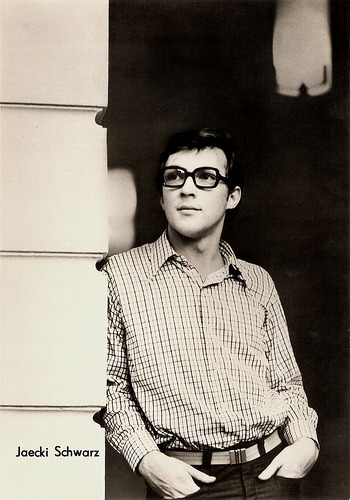
Big East-German card by VEB Progress Filmvertrieb, Berlin, no. 351/60, 1969. Photo: Uhlenhut.
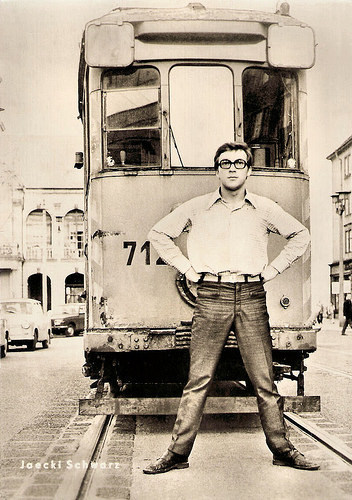
East-German postcard by VEB Progress Filmvertrieb, Berlin, no. 207/70, 1970. Photo: Uhlenhut.
Police Call 110
During the 1970s, Jaecki Schwarz played supporting parts in such films as the fairy tale Das blaue Licht/The Blue Light (Iris Gusner, 1976) and the comedy Einfach Blumen aufs Dach/Simply flowers on the roof (Roland Oehme, 1979).
During the following decades he played supporting parts in films, e.g. in Bürgschaft für ein Jahr/Guarantee for one year (Herrmann Zschoche, 1981), the comedy Märkische Forschungen/Exploring the Brandenburg Marches (Roland Gräf, 1982), the family film Hasenherz/Rabbit heart (Gunter Friedrich, 1988) and the road movie Burning Life (Peter Welz, 1994) with Maria Schrader, but he worked more and more for TV.
After the fall of the Berlin Wall in 1989, Schwarz easily continued his television career. From 1996 on, he played police chief Herbert Schmücke in the long-running Krimi series Polizeiruf 110/Police Call 110. The series was originally created in the GDR as a counterpart to the West German Krimi series Tatort, and quickly became a public favourite. Schwarz’s 50th and final case in the series was broadcast on 3 March 2013. In the ZDF series Ein starkes Team/A strong team (1994-), Schwarz plays the supporting role of Sputnik.
In 2004, Schwarz officially announced that he is gay. Schwarz is one of the members of the Board of Trustees of the Initiative Queer Nations. In addition, he serves as a honorary ambassador of a Children's Foundation Hospice Central. in Tambach-Dietharz.
Jaecki Schwarz has appeared in more than 120 films and TV productions. He lives in Berlin.
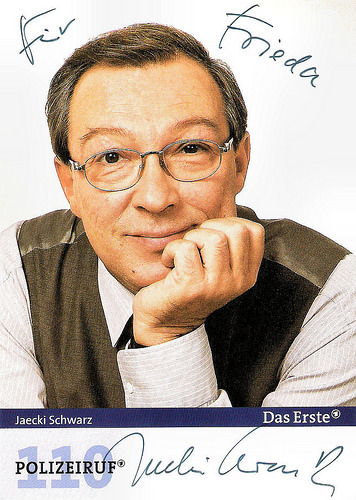
German promotion card by Das Erste MDR Fernsehen, Leipzig. Photo: fmp Hillert. Publicity still for Polizeiruf 110/Police Call 110 (1996-2013).
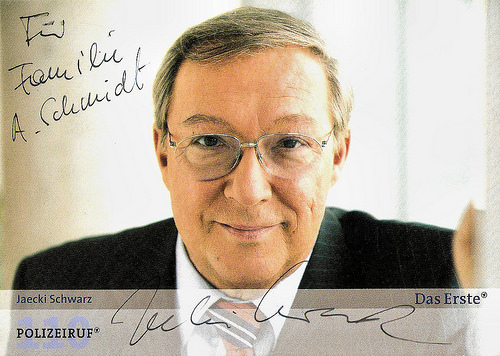
German promotion card by Das Erste MDR Fernsehen, Leipzig. Photo: MDR / Martin Jehnichen. Publicity still for Polizeiruf 110/Police Call 110 (1996-2013).
Trailer Hasenherz/Rabbit heart (Gunter Friedrich, 1988). Source: DEFA-Stiftung (YouTube).
Sources: Ines Walk (FilmZeit.de – German), Wikipedia (German), and .

East-German card by VEB Progress Filmvertrieb, Berlin, no. 3297, 1968. Photo: Uhlenhut.

East-German card by VEB Progress Filmvertrieb, Berlin, no. 134/69, 1969. Photo: Uhlenhut.
I was nineteen
Jaecki Schwarz was born in Berlin in 1946. He attended the Alexander von Humboldt high school in Berlin, and completed an apprenticeship as a photo chemical technician. Then he applied twice at various drama schools, but after the aptitude test he was rejected. On the third try he succeeded and between 1965 and 1969, he studied at the Konrad Wolf Academy of Film and Television in Potsdam-Babelsberg.
Still a student, he became famous when he starred in the DEFA film Ich war neunzehn/I was nineteen (Konrad Wolf, 1968). In this film, Schwarz plays a young German, Gregor Hecker, who when he was eight fled the Nazis with his parents to Moscow. In early 1945, he returns to Germany as a lieutenant in the Red Army and is confronted with the dilemma of having to fight men from the very country he was born in. The film depicts the personal experiences of the director Konrad Wolf and of his friend Vladimir Gall in fictionalised form and deals with themes of the meaning of ‘homeland’.
William Shackleford at IMDb : “The intent of the movie, made in the GDR at a time when they were barraged with propaganda trying to make them believe that Russians were their friends, is obvious. Nevertheless, I did enjoy watching it, because even propaganda can be interesting for what it is.”
During its original run, Ich war neunzehn sold 3,317,966 tickets and this made it one of the highest grossing DEFA films ever. Schwaerz played leading roles in DEFA films like Weite Strassen stille Liebe/Wide streets silent love (Herrmann Zschoche, 1969) with Manfred Krug, Du und ich und Klein-Paris/You and Me and Little-Paris (Werner W. Wallroth, 1971), and Die Schlüssel/The Key (Egon Günther, 1972) starring Jutta Hoffmann.
He also became also a busy theatre actor and played on the stages of the City theatre of Magdeburg (1969-1974), the Berliner Ensemble (1974-1997) and at the Maxim Gorki Theater in Berlin. However, Schwarz appeared particularly in countless television films.

Big East-German card by VEB Progress Filmvertrieb, Berlin, no. 351/60, 1969. Photo: Uhlenhut.

East-German postcard by VEB Progress Filmvertrieb, Berlin, no. 207/70, 1970. Photo: Uhlenhut.
Police Call 110
During the 1970s, Jaecki Schwarz played supporting parts in such films as the fairy tale Das blaue Licht/The Blue Light (Iris Gusner, 1976) and the comedy Einfach Blumen aufs Dach/Simply flowers on the roof (Roland Oehme, 1979).
During the following decades he played supporting parts in films, e.g. in Bürgschaft für ein Jahr/Guarantee for one year (Herrmann Zschoche, 1981), the comedy Märkische Forschungen/Exploring the Brandenburg Marches (Roland Gräf, 1982), the family film Hasenherz/Rabbit heart (Gunter Friedrich, 1988) and the road movie Burning Life (Peter Welz, 1994) with Maria Schrader, but he worked more and more for TV.
After the fall of the Berlin Wall in 1989, Schwarz easily continued his television career. From 1996 on, he played police chief Herbert Schmücke in the long-running Krimi series Polizeiruf 110/Police Call 110. The series was originally created in the GDR as a counterpart to the West German Krimi series Tatort, and quickly became a public favourite. Schwarz’s 50th and final case in the series was broadcast on 3 March 2013. In the ZDF series Ein starkes Team/A strong team (1994-), Schwarz plays the supporting role of Sputnik.
In 2004, Schwarz officially announced that he is gay. Schwarz is one of the members of the Board of Trustees of the Initiative Queer Nations. In addition, he serves as a honorary ambassador of a Children's Foundation Hospice Central. in Tambach-Dietharz.
Jaecki Schwarz has appeared in more than 120 films and TV productions. He lives in Berlin.

German promotion card by Das Erste MDR Fernsehen, Leipzig. Photo: fmp Hillert. Publicity still for Polizeiruf 110/Police Call 110 (1996-2013).

German promotion card by Das Erste MDR Fernsehen, Leipzig. Photo: MDR / Martin Jehnichen. Publicity still for Polizeiruf 110/Police Call 110 (1996-2013).
Trailer Hasenherz/Rabbit heart (Gunter Friedrich, 1988). Source: DEFA-Stiftung (YouTube).
Sources: Ines Walk (FilmZeit.de – German), Wikipedia (German), and .
Published on January 09, 2016 22:00
January 8, 2016
EFSP's Dazzling Dozen: Smoke Gets In Your Eyes
In the fantasy world of the cinema, cigarettes have always been one of the ultimate props. On the silver screen, a lit square can lent an air of rebellion to the smoker, who suddenly becomes more charming or sultry. Yes, filmmakers know that smoking leads to increased risks of stroke and lung diseases like emphysema. In the 1980s, Hollywood responded to no-smoking campaigns by cutting the rate at which its stars lit up on-screen to 4.9 times per hour, less than half the 1950s rate of 10.7. But in a recent study, the on-screen smoking rate has shot back up to 10.9. Twelve postcards that show that smoking often looks cool. Often, not always.
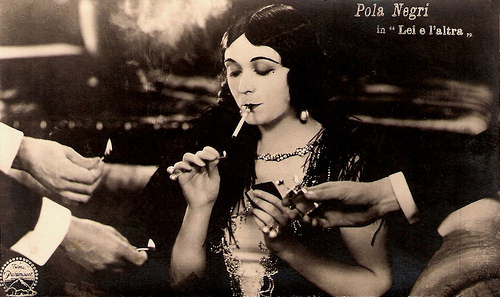
Pola Negri . Italian postcard by Ed. Ballerini & Fratini, Firenze. Photo: publicity still for Good and Naughty (Malcolm St. Clair, 1926).
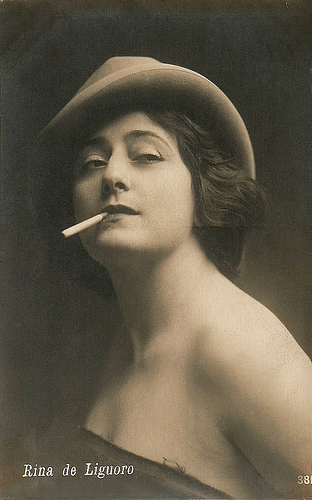
Rina de Liguoro . Italian postcard by Ballerini & Fratini, Firenze, no. 381.
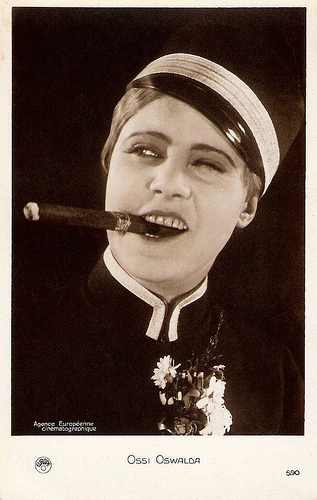
Ossi Oswalda . French postcard in the Europe series, no. 590. Photo: Agence Européenne Cinematographique.
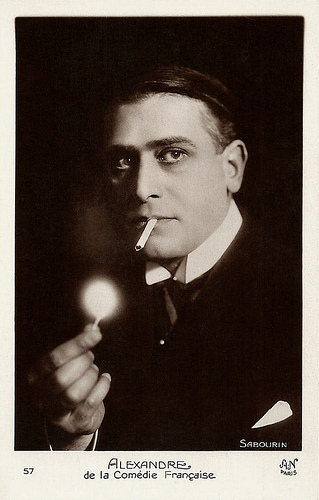
René Alexandre . French postcard by A.N., Paris, no. 57. Photo: Sabourin. Caption: Alexandre de la Comédie Française.
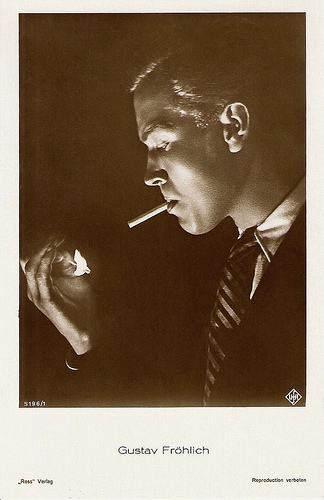
Gustav Fröhlich . German postcard by Ross Verlag, no. 5196/1, 1930-1931. Photo: Ufa.
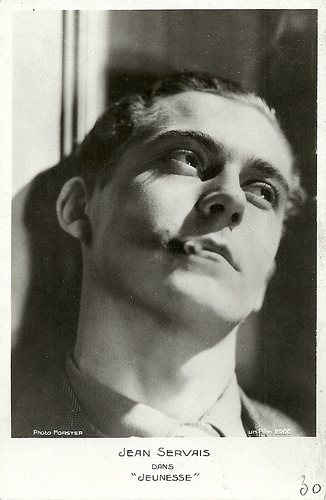
Jean Servais . French postcard. Photo: Forster / Films Epoc. Publicity still for Jeunesse/Youth (Georges Lacombe, 1934).
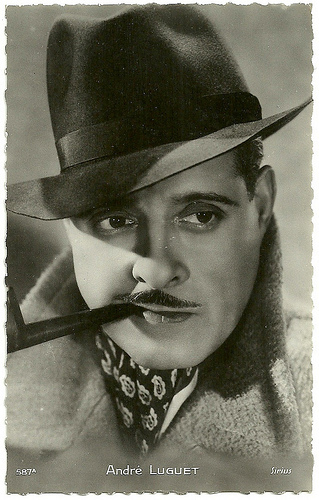
André Luguet . French postcard by Editions Chantal, Rueil, no. 587a. Photo: Sirius.
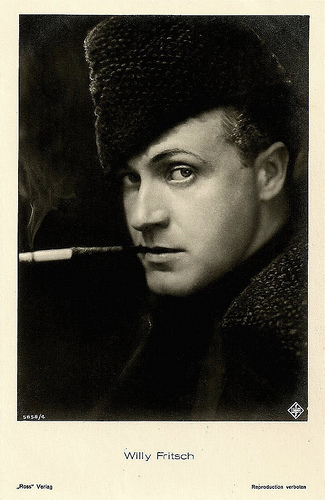
Willy Fritsch . German postcard by Ross Verlag, no. 5858/4, 1930-1931. Photo: Ufa. Publicity still for Im Geheimdienst/In Secret Service (Gustav von Ucicky, 1931), a spy film set in Russia in World War One.
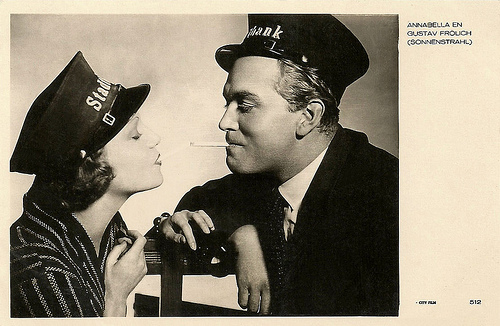
Annabella and Gustav Fröhlich . Dutch postcard by City Film, no. 512. Photo: publicity still for the Austrian film Sonnenstrahl/Ray of Sunlight (Pål Fejös, 1933).
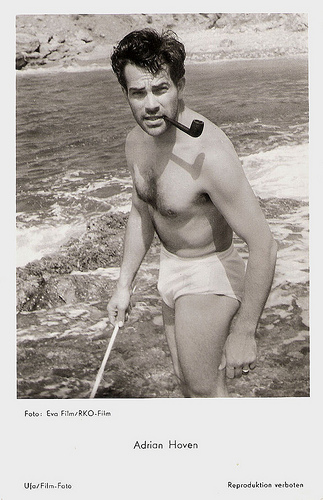
Adrian Hoven . German postcard by Ufa, Berlin-Tempelhof, no. FK 1888. Photo: Eva-Film / RKO-Film. Publicity still for Solange Du Lebst/As Long as You Live (Harald Reinl, 1955).
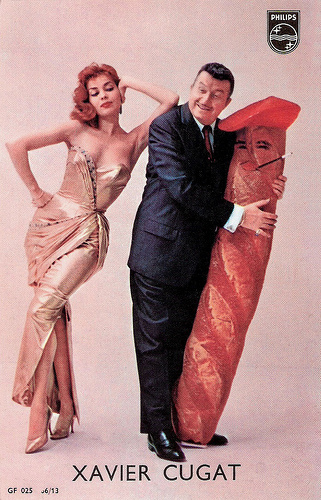
Abbe Lane and Xavier Cugat. Promotion card by Philips, no. GF 025 66/13.
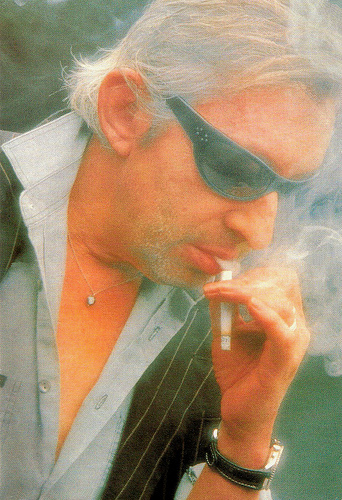
Serge Gainsbourg . French postcard, no. A100.
And no, here at EFSP, we don't smoke.
This is a post for Postcard Friendship Friday, hosted by Beth at the The Best Hearts are Crunchy. You can visit her by clicking on the button below.

Sources: Gerard Gilbert (The Independent), and Javy Rodriguez (Complex).

Pola Negri . Italian postcard by Ed. Ballerini & Fratini, Firenze. Photo: publicity still for Good and Naughty (Malcolm St. Clair, 1926).

Rina de Liguoro . Italian postcard by Ballerini & Fratini, Firenze, no. 381.

Ossi Oswalda . French postcard in the Europe series, no. 590. Photo: Agence Européenne Cinematographique.

René Alexandre . French postcard by A.N., Paris, no. 57. Photo: Sabourin. Caption: Alexandre de la Comédie Française.

Gustav Fröhlich . German postcard by Ross Verlag, no. 5196/1, 1930-1931. Photo: Ufa.

Jean Servais . French postcard. Photo: Forster / Films Epoc. Publicity still for Jeunesse/Youth (Georges Lacombe, 1934).

André Luguet . French postcard by Editions Chantal, Rueil, no. 587a. Photo: Sirius.

Willy Fritsch . German postcard by Ross Verlag, no. 5858/4, 1930-1931. Photo: Ufa. Publicity still for Im Geheimdienst/In Secret Service (Gustav von Ucicky, 1931), a spy film set in Russia in World War One.

Annabella and Gustav Fröhlich . Dutch postcard by City Film, no. 512. Photo: publicity still for the Austrian film Sonnenstrahl/Ray of Sunlight (Pål Fejös, 1933).

Adrian Hoven . German postcard by Ufa, Berlin-Tempelhof, no. FK 1888. Photo: Eva-Film / RKO-Film. Publicity still for Solange Du Lebst/As Long as You Live (Harald Reinl, 1955).

Abbe Lane and Xavier Cugat. Promotion card by Philips, no. GF 025 66/13.

Serge Gainsbourg . French postcard, no. A100.
And no, here at EFSP, we don't smoke.
This is a post for Postcard Friendship Friday, hosted by Beth at the The Best Hearts are Crunchy. You can visit her by clicking on the button below.

Sources: Gerard Gilbert (The Independent), and Javy Rodriguez (Complex).
Published on January 08, 2016 22:00
January 7, 2016
Silvana Pampanini (1925-2016)
Last Wednesday, gorgeous Italian actress Silvana Pampanini died. She knew enormous popularity in the 1950s and 1960s. In the early 1950s, before Sophia Loren and Gina Lollobrigida reached stardom, Pampanini was one of the most well-known symbols of Italian beauty. Silvana Pampanini was 90.
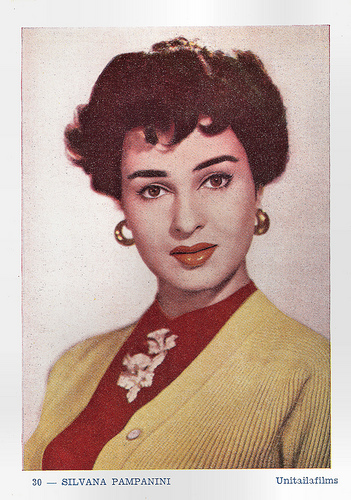
Belgian collectors card by Merbotex, Bruxelles / Ciné Rio, Flénu, no. 30. Photo: Unitalia Films.
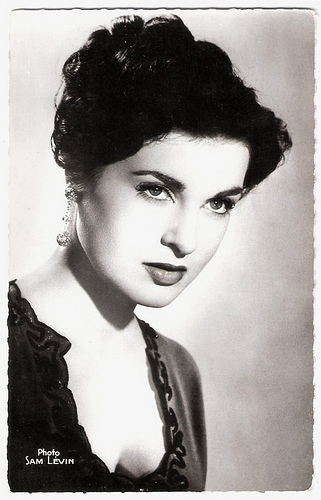
French postcard by Editions du Globe, (E.D.U.G.). no. 462. Photo: Sam Lévin.
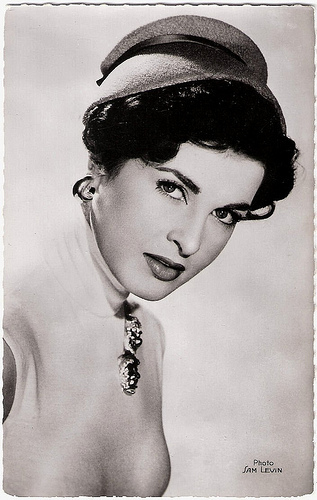
French postcard by Editions du Globe, (E.D.U.G.). no. 348. Photo: Sam Lévin.
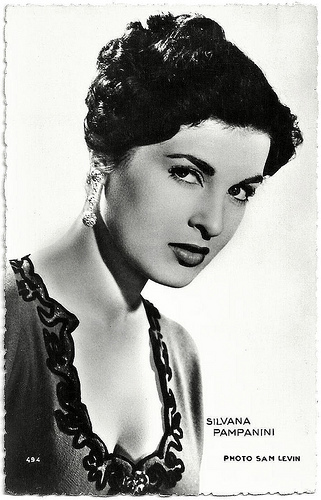
French postcard by Editions P.I., Paris, no. 494. Photo: Sam Lévin.
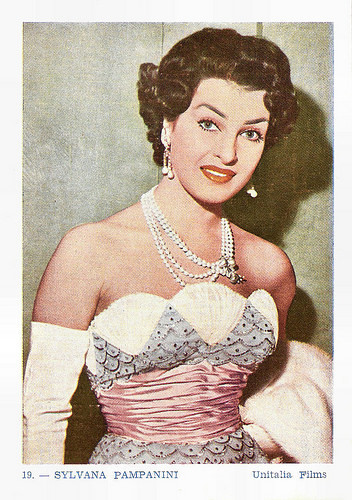
Belgian collectors card by Merbotex, Bruxelles / Palace Izegem, no. 19. Photo: Unitalia Films.
The Toast of Weeklies and Film Magazines
Silvana Pampanini was born in Rome in 1925. Her family had moved there from the Veneto some three centuries ago.
Pampanini got her law degree during the war and visited the Conservatory of Santa Cecilia where she got a degree in piano and song. As a singer, the young Pampanini made career within entertainment music. Her songs were widespread on unique records, and she even got an audience with pope Pio XII. Over the years she also was a frequent visitor of the opera seasons. Her cousin was the soprano Rosetta Pampanini.
When the Second World War was over, her singing master inscribed her for the Miss Italia contest in Stresa in September 1946 which she won ex aequo with Rossana Martini, thanks to a fierce audience reaction after Martin had originally been chosen by the jury. Her Miss Italia title was her introduction to a career in the cinema.
Pampanini made her debut in the film L’Apocalisse/Apocalypse (Giuseppe Maria Scottese, 1948) and went on to perform in various films, often musicals. She became also the toast of weeklies and film magazines. Her father, who originally had been against his daughter's acting career, became her agent. Even if she was dubbed in her first roles, Pampanini became a star.
The sexy actress performed with all the great actors of the postwar Italian cinema: Totò , Peppino De Filippo , Alberto Sordi , Vittorio De Sica , Marcello Mastroianni , Nino Manfredi , Vittorio Gassman , Walter Chiari , Amedeo Nazzari , Raf Vallone , Massimo Girotti , Ugo Tognazzi , Rossano Brazzi , and Massimo Serato .
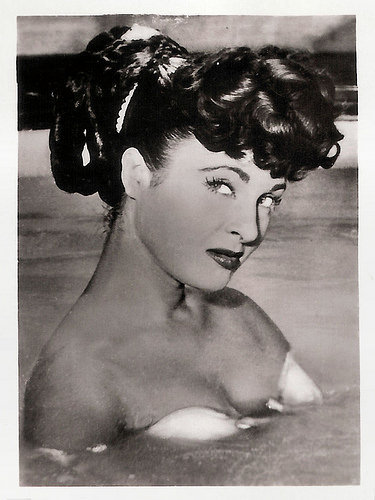
German collectors card by Greiling Sammelbilder in the series Filmstars der Welt, 2. Band, Serie E, no. 102. Photo: Allianz Film. Publicity still for O.K. Nerone/O.K. Nero (Mario Soldati, 1951).
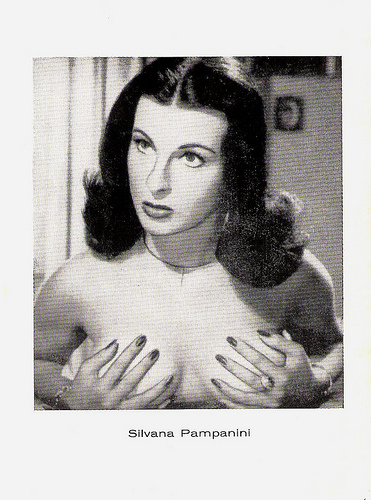
Vintage card.
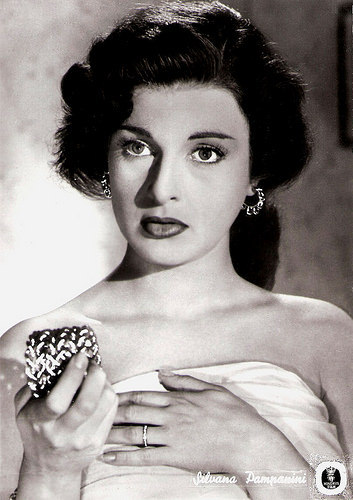
Italian postcard by Bromofoto, Milano, no. 339. Photo: Minerva Film.
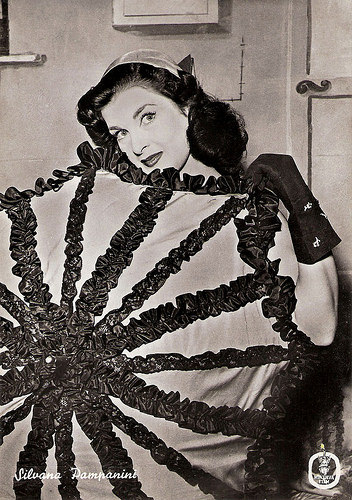
Italian postcard by Bromofoto, Milano, no. 668. Sent by mail in 1966. Photo: Minerva Film.
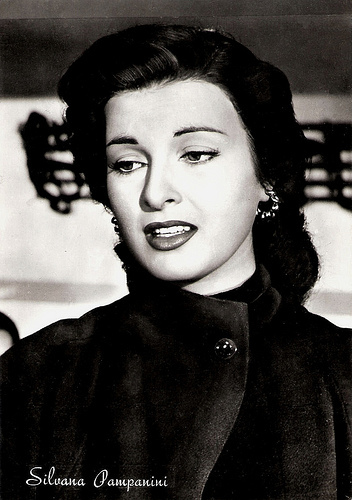
Italian postcard by Rotalfoto, Milano, no. 125. Photo: Ponti - De Laurentiis.

Italian postcard by Rotalfoto, Milano, no. 482. Sent by mail in 1960.
Beauty on a Bike
In the 1950s, Silvana Pampanini played in one film after another and many of her films were distributed worldwide. Well known was for instance the Dino de Laurentiis production I pompieri di Viggiù/The Firemen of Viggiu (Mario Mattoli, 1949), with Totò . Ennio Flaiano considered it rather a series of vaudeville acts than a film, and thus preceding TV vaudeville.
With the Quo vadis? parody OK Nerone/O.K. Nero (Mario Soldati, 1951), Pampanini had her first international success as Empress Poppea, opposite Gino Cervi as Nero, and Walter Chiari and Carlo Campanini as two American sailors who dream that they are in Nero’s Rome. In the romantic comedy Bellezze in bicicletta/Beauties on a Bike (Carlo Campogalliani, 1951) she formed a pair with Delia Scala and sang one of the most beloved songs of the time: Bellezza in bicicletta.
In 1952 Pampanini performed in the much awarded Processo alla città/The City Stands Trial (Luigi Zampa, 1952), starring Amedeo Nazzari ; La presidentessa/Mademoiselle Gobete (Pietro Germi, 1952), and La tratta delle bianche/White Slave Trade (Luigi Comencini, 1952). The latter also casted Eleonora Rossi-Drago , Tamara Lees and (in a smaller part) Sophia Loren , but the leading men Vittorio Gassman and Marc Lawrence both have set their eyes on Silvana.
In 1953 Pampanini played in an episode of Un giorno in pretura (Steno, 1953) for which her make-up man transformed her in a lady 30 years older. That year she was also the title character in the melodrama Un marito per Anna Zaccheo/A Husband for Anna (Giuseppe de Santis, 1953), which costarred Amedeo Nazzari and Massimo Girotti .
In 1955 Pampanini performed opposite Alberto Sordi and Paolo Stoppa in the comedy La bella di Roma/The Belle of Rome (Luigi Comencini, 1955), and she played in the box office hit Racconti romani/Roman Tales (Gianni Franciolini, 1955), based on a story by Alberto Moravia, and starring Franco Fabrizi. Finally Pampanini played in the Italian-Yugoslavian coproduction La strada lunga un anno/The Year Long Road (Giuseppe De Santis, 1958), an Oscar candidate in 1959 and Golden Globe winner for best foreign picture.
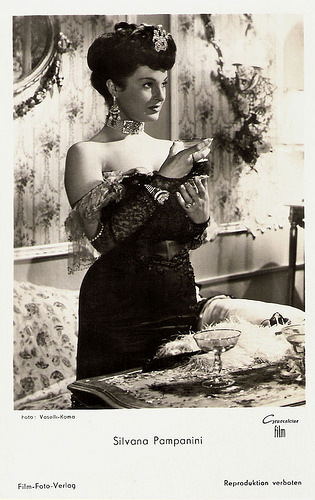
German postcard by Ufa, Berlin-Tempelhof, no. FK 493. Photo: Vaselli, Roma / Generalcine Film. Publicity still for La donna che inventò l'amore/The Woman Who Invented Love (Ferruccio Cerio, 1952).
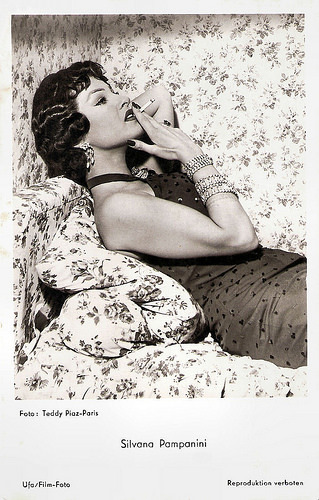
German postcard by Ufa, Berlin-Tempelhof, no. FK 2246. Photo: Teddy Piaz, Paris.
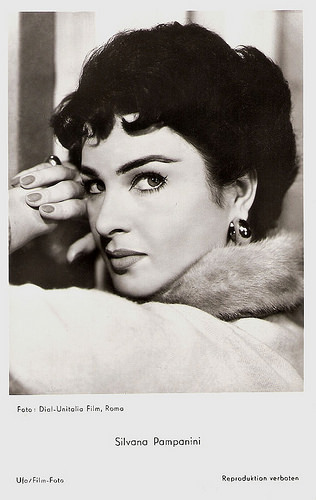
German postcard by Ufa, Berlin-Charlottenburg, no. FK 2247. Photo: Dial - Unitalia Film, Roma.
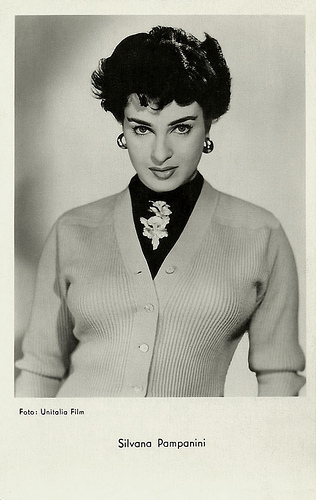
Franco-German card by Ufa, Berlin/ Editions P.I., Paris. Photo: Unitalia Film
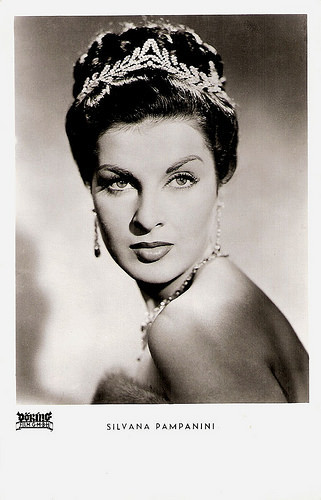
German postcard by Kunst und Bild, Berlin, no. T 603. Photo: Döring Film GmbH. Publicity still for Königsmark (Solange Térac, 1953).
Declining Diva
Even when she was in America, Silvana Pampanini refused to act in Hollywood, presumably because her English was not good enough. She did play in France, where she was known as Niní Pampan. Examples are La tour de Nesle/Tower of Lust (Abel Gance, 1955) in which she played Marguerite de Bourgogne opposite Pierre Brasseur as Jehan Buridan, and La loi des rues/Law of the Streets (Ralph Habib, 1956), with Raymond Pellegrin .
She also played in films in Spain, where she starred in La principessa delle Canarie/The Island Princess (Paolo Moffa, Carlos Serrano de Osma, 1954), Germany, Greece, Yugoslavia, Egypt, Argentine, and in particular in Mexico, where she played in some films that never were released in Italy, such as Sed de amor/Thirst for Love (Alfonso Corona Blake, 1959) with Pedro Armendariz, and the comedy Napoleoncito (Gilberto Martinez Solares, 1964).
In the meantime the yellow press published about Pampanini's flirts with prince Ahmad Shah Khan, Tyrone Power , William Holden, George DeWitt, Omar Sharif, Orson Welles , king Faruq of Egypt and others. Pampanini herself told that her one true love, a ten years older man, not involved in cinema and never identified, died of a disease one month before their wedding. After a brief experience as director and screenwriter in 1958, Pampanini slowed down her film career and focused on radio and TV, where she worked as announcer and host.
In 1964 Dino Risi directed her in Il gaucho/The Gaucho (Dino Risi, 1964), a partly autobiographical film in which Silvana played a declining diva, who pathetically searches for her lost glory and for a millionaire to marry. In 1966, after a career of twenty years, Pampanini retired in order to assist her aging parents whom she took care of till their death. She returned for one last role as a prostitute in an episode of Mazzabubù... Quante corna stanno quaggiù? (Mariano Laurenti, 1971) with Giancarlo Giannini and Sylva Koscina . After that she was only visible once more, as herself in Tassinaro (Alberto Sordi, 1983).
In the TV mini-series Tre stelle (Pier Francesco Pingitore, 1999) she had a bit part as the old mother of Alba Parietti and in the fall of 2002 she hosted the TV-show Domenica In during two months. Pampanini was devoted to Padre Pio and San Antonio. She never married nor had any children. However, she was proud that once Totò proposed to her, on the set of 47 morto che parla (Carlo Ludovico Bragaglia, 1950), even if he asked in vain.
In her roaring years Pampanini was not very beloved by the critics and she did not receive important awards, which caused her in her autobiography Scandalosamente perbene (Shockingly respectable, 1996), to compare herself with Greta Garbo . Pampanini never was afraid to keep silent, so in December 2006 she publicly mocked Gina Lollobrigida for marrying a much younger man, and when in 2008 mayor Walter Veltroni did not invite her for the Festa del Cinema in Rome, she started a serious polemic.
In 2007 she did participate in the festivities of 70 years Cinecittà and in 2009 she hosted the Mostra del Cinema dello Stretto which brought a warm welcome and the recognition of her career. Though living in Monaco, Pampanini was nominated Grande ufficiale dell'ordine al merito della Repubblica Italiana in 2003 by president Ciampi. In September 2009 she returned at the Venice film festival for the projection of the restored version of Noi cannibali/We Cannibals (Antonio Leonviola, 1953), a film inserted in the section Questi fantasmi 2 (These ghosts 2), dedicated to Italian films to be reconsidered. Silvana Pampanini died on 6 January 2016 in Rome, Italy.
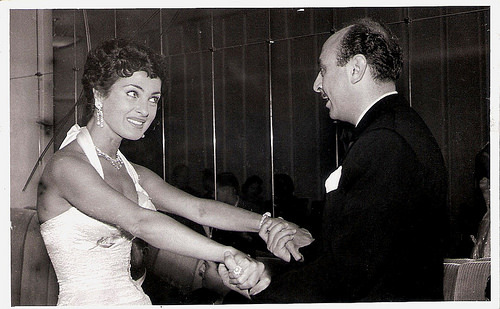
French postcard. Silvana Pampanini greets the representative of the Mexican production.
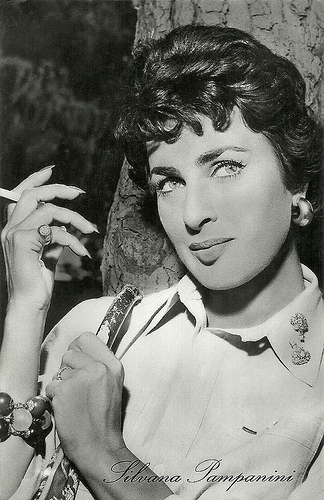
East-German card by VEB Progress Film Vertrieb, Berlin, no. 511. Photo: Unitalia Film.
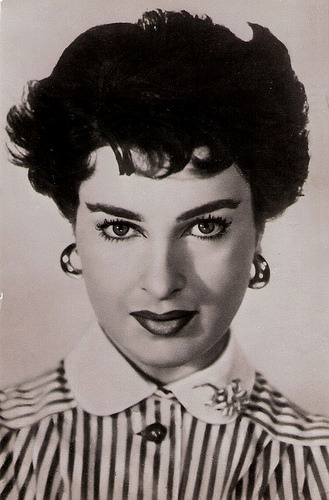
Russian postcard, no. 17860, 1959.
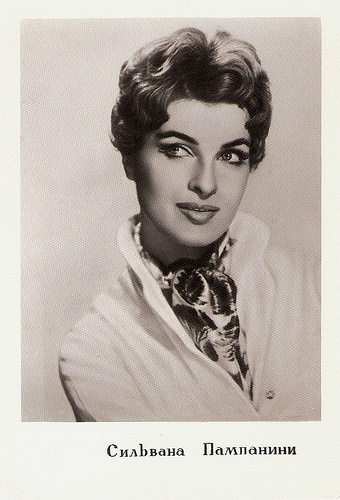
Russian postcard, no. M 49010, 1960.
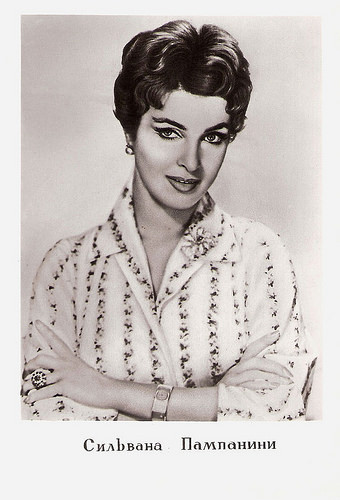
Russian postcard, no. M 49010.18, 1960.
Scene from Bellezze in bicicletta/Beauties on a Bike (1951). (No subtitles). Source: always the sun (YouTube).
“Ma dove vai bellezza in bicicletta,
così di fretta pedalando con ardor?
Le gambe snelle tornite e belle
m'hanno già messo la passione dentro al cuor!”
Sources: Sandra Brennan (AllMovie), Wikipedia (Italian and English), and .

Belgian collectors card by Merbotex, Bruxelles / Ciné Rio, Flénu, no. 30. Photo: Unitalia Films.

French postcard by Editions du Globe, (E.D.U.G.). no. 462. Photo: Sam Lévin.

French postcard by Editions du Globe, (E.D.U.G.). no. 348. Photo: Sam Lévin.

French postcard by Editions P.I., Paris, no. 494. Photo: Sam Lévin.

Belgian collectors card by Merbotex, Bruxelles / Palace Izegem, no. 19. Photo: Unitalia Films.
The Toast of Weeklies and Film Magazines
Silvana Pampanini was born in Rome in 1925. Her family had moved there from the Veneto some three centuries ago.
Pampanini got her law degree during the war and visited the Conservatory of Santa Cecilia where she got a degree in piano and song. As a singer, the young Pampanini made career within entertainment music. Her songs were widespread on unique records, and she even got an audience with pope Pio XII. Over the years she also was a frequent visitor of the opera seasons. Her cousin was the soprano Rosetta Pampanini.
When the Second World War was over, her singing master inscribed her for the Miss Italia contest in Stresa in September 1946 which she won ex aequo with Rossana Martini, thanks to a fierce audience reaction after Martin had originally been chosen by the jury. Her Miss Italia title was her introduction to a career in the cinema.
Pampanini made her debut in the film L’Apocalisse/Apocalypse (Giuseppe Maria Scottese, 1948) and went on to perform in various films, often musicals. She became also the toast of weeklies and film magazines. Her father, who originally had been against his daughter's acting career, became her agent. Even if she was dubbed in her first roles, Pampanini became a star.
The sexy actress performed with all the great actors of the postwar Italian cinema: Totò , Peppino De Filippo , Alberto Sordi , Vittorio De Sica , Marcello Mastroianni , Nino Manfredi , Vittorio Gassman , Walter Chiari , Amedeo Nazzari , Raf Vallone , Massimo Girotti , Ugo Tognazzi , Rossano Brazzi , and Massimo Serato .

German collectors card by Greiling Sammelbilder in the series Filmstars der Welt, 2. Band, Serie E, no. 102. Photo: Allianz Film. Publicity still for O.K. Nerone/O.K. Nero (Mario Soldati, 1951).

Vintage card.

Italian postcard by Bromofoto, Milano, no. 339. Photo: Minerva Film.

Italian postcard by Bromofoto, Milano, no. 668. Sent by mail in 1966. Photo: Minerva Film.

Italian postcard by Rotalfoto, Milano, no. 125. Photo: Ponti - De Laurentiis.

Italian postcard by Rotalfoto, Milano, no. 482. Sent by mail in 1960.
Beauty on a Bike
In the 1950s, Silvana Pampanini played in one film after another and many of her films were distributed worldwide. Well known was for instance the Dino de Laurentiis production I pompieri di Viggiù/The Firemen of Viggiu (Mario Mattoli, 1949), with Totò . Ennio Flaiano considered it rather a series of vaudeville acts than a film, and thus preceding TV vaudeville.
With the Quo vadis? parody OK Nerone/O.K. Nero (Mario Soldati, 1951), Pampanini had her first international success as Empress Poppea, opposite Gino Cervi as Nero, and Walter Chiari and Carlo Campanini as two American sailors who dream that they are in Nero’s Rome. In the romantic comedy Bellezze in bicicletta/Beauties on a Bike (Carlo Campogalliani, 1951) she formed a pair with Delia Scala and sang one of the most beloved songs of the time: Bellezza in bicicletta.
In 1952 Pampanini performed in the much awarded Processo alla città/The City Stands Trial (Luigi Zampa, 1952), starring Amedeo Nazzari ; La presidentessa/Mademoiselle Gobete (Pietro Germi, 1952), and La tratta delle bianche/White Slave Trade (Luigi Comencini, 1952). The latter also casted Eleonora Rossi-Drago , Tamara Lees and (in a smaller part) Sophia Loren , but the leading men Vittorio Gassman and Marc Lawrence both have set their eyes on Silvana.
In 1953 Pampanini played in an episode of Un giorno in pretura (Steno, 1953) for which her make-up man transformed her in a lady 30 years older. That year she was also the title character in the melodrama Un marito per Anna Zaccheo/A Husband for Anna (Giuseppe de Santis, 1953), which costarred Amedeo Nazzari and Massimo Girotti .
In 1955 Pampanini performed opposite Alberto Sordi and Paolo Stoppa in the comedy La bella di Roma/The Belle of Rome (Luigi Comencini, 1955), and she played in the box office hit Racconti romani/Roman Tales (Gianni Franciolini, 1955), based on a story by Alberto Moravia, and starring Franco Fabrizi. Finally Pampanini played in the Italian-Yugoslavian coproduction La strada lunga un anno/The Year Long Road (Giuseppe De Santis, 1958), an Oscar candidate in 1959 and Golden Globe winner for best foreign picture.

German postcard by Ufa, Berlin-Tempelhof, no. FK 493. Photo: Vaselli, Roma / Generalcine Film. Publicity still for La donna che inventò l'amore/The Woman Who Invented Love (Ferruccio Cerio, 1952).

German postcard by Ufa, Berlin-Tempelhof, no. FK 2246. Photo: Teddy Piaz, Paris.

German postcard by Ufa, Berlin-Charlottenburg, no. FK 2247. Photo: Dial - Unitalia Film, Roma.

Franco-German card by Ufa, Berlin/ Editions P.I., Paris. Photo: Unitalia Film

German postcard by Kunst und Bild, Berlin, no. T 603. Photo: Döring Film GmbH. Publicity still for Königsmark (Solange Térac, 1953).
Declining Diva
Even when she was in America, Silvana Pampanini refused to act in Hollywood, presumably because her English was not good enough. She did play in France, where she was known as Niní Pampan. Examples are La tour de Nesle/Tower of Lust (Abel Gance, 1955) in which she played Marguerite de Bourgogne opposite Pierre Brasseur as Jehan Buridan, and La loi des rues/Law of the Streets (Ralph Habib, 1956), with Raymond Pellegrin .
She also played in films in Spain, where she starred in La principessa delle Canarie/The Island Princess (Paolo Moffa, Carlos Serrano de Osma, 1954), Germany, Greece, Yugoslavia, Egypt, Argentine, and in particular in Mexico, where she played in some films that never were released in Italy, such as Sed de amor/Thirst for Love (Alfonso Corona Blake, 1959) with Pedro Armendariz, and the comedy Napoleoncito (Gilberto Martinez Solares, 1964).
In the meantime the yellow press published about Pampanini's flirts with prince Ahmad Shah Khan, Tyrone Power , William Holden, George DeWitt, Omar Sharif, Orson Welles , king Faruq of Egypt and others. Pampanini herself told that her one true love, a ten years older man, not involved in cinema and never identified, died of a disease one month before their wedding. After a brief experience as director and screenwriter in 1958, Pampanini slowed down her film career and focused on radio and TV, where she worked as announcer and host.
In 1964 Dino Risi directed her in Il gaucho/The Gaucho (Dino Risi, 1964), a partly autobiographical film in which Silvana played a declining diva, who pathetically searches for her lost glory and for a millionaire to marry. In 1966, after a career of twenty years, Pampanini retired in order to assist her aging parents whom she took care of till their death. She returned for one last role as a prostitute in an episode of Mazzabubù... Quante corna stanno quaggiù? (Mariano Laurenti, 1971) with Giancarlo Giannini and Sylva Koscina . After that she was only visible once more, as herself in Tassinaro (Alberto Sordi, 1983).
In the TV mini-series Tre stelle (Pier Francesco Pingitore, 1999) she had a bit part as the old mother of Alba Parietti and in the fall of 2002 she hosted the TV-show Domenica In during two months. Pampanini was devoted to Padre Pio and San Antonio. She never married nor had any children. However, she was proud that once Totò proposed to her, on the set of 47 morto che parla (Carlo Ludovico Bragaglia, 1950), even if he asked in vain.
In her roaring years Pampanini was not very beloved by the critics and she did not receive important awards, which caused her in her autobiography Scandalosamente perbene (Shockingly respectable, 1996), to compare herself with Greta Garbo . Pampanini never was afraid to keep silent, so in December 2006 she publicly mocked Gina Lollobrigida for marrying a much younger man, and when in 2008 mayor Walter Veltroni did not invite her for the Festa del Cinema in Rome, she started a serious polemic.
In 2007 she did participate in the festivities of 70 years Cinecittà and in 2009 she hosted the Mostra del Cinema dello Stretto which brought a warm welcome and the recognition of her career. Though living in Monaco, Pampanini was nominated Grande ufficiale dell'ordine al merito della Repubblica Italiana in 2003 by president Ciampi. In September 2009 she returned at the Venice film festival for the projection of the restored version of Noi cannibali/We Cannibals (Antonio Leonviola, 1953), a film inserted in the section Questi fantasmi 2 (These ghosts 2), dedicated to Italian films to be reconsidered. Silvana Pampanini died on 6 January 2016 in Rome, Italy.

French postcard. Silvana Pampanini greets the representative of the Mexican production.

East-German card by VEB Progress Film Vertrieb, Berlin, no. 511. Photo: Unitalia Film.

Russian postcard, no. 17860, 1959.

Russian postcard, no. M 49010, 1960.

Russian postcard, no. M 49010.18, 1960.
Scene from Bellezze in bicicletta/Beauties on a Bike (1951). (No subtitles). Source: always the sun (YouTube).
“Ma dove vai bellezza in bicicletta,
così di fretta pedalando con ardor?
Le gambe snelle tornite e belle
m'hanno già messo la passione dentro al cuor!”
Sources: Sandra Brennan (AllMovie), Wikipedia (Italian and English), and .
Published on January 07, 2016 22:00
January 6, 2016
Imported from the USA: Dorothy Dandridge
Dorothy Dandridge (1922-1965) was an American film and theatre actress, singer and dancer. She is perhaps best known for being the first African-American actress to be nominated for an Academy Award for Best Actress for her performance in Carmen Jones (Otto Preminger, 1954). She was nominated for a Golden Globe Award for Porgy and Bess (Otto Preminger, 1959). Dandridge also appeared in a few European films.
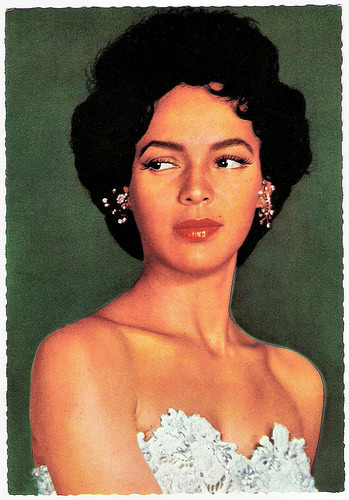
German postcard by ISV. Photo: 20th Century Fox. Publicity still for Carmen Jones (Otto Preminger, 1954).

German postcard by Ufa, Berlin-Tempelhof, WP no. 14. Photo: Centfox.
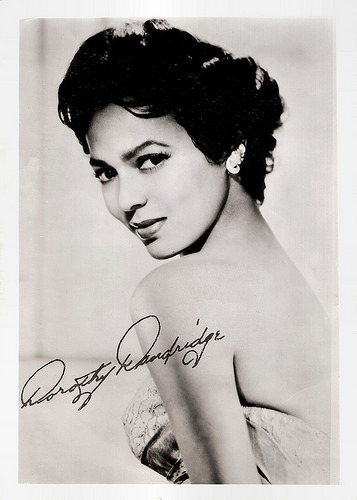
Vintage photo.
The Wonder Children
Dorothy Jean Dandridge was born in, 1922 in Cleveland, Ohio, to Ruby Dandridge (née Ruby Jean Butler), an entertainer, and Cyril H. Dandridge, a cabinet maker and minister.
Under the prodding of her mother, Dorothy and her sister Vivian Dandridge began performing publicly, as the Wonder Children, later The Dandridge Sisters, usually in black Baptist churches throughout the country. Her mother would often join her daughters on stage.
During her early career, Dorothy appeared in a succession of films, usually in uncredited roles. Her film debut was a bit role in the Marx Brothers comedy, A Day at the Races (Sam Wood, 1937). She also performed as a vocalist in the Cotton Club and the Apollo Theater.
Her breakthrough was her title role in the all-black production of Carmen Jones (Otto Preminger, 1954). Dandridge's performance as the sultry title character made her one of Hollywood's first African-American sex symbols. Carmen Jones became a worldwide success, eventually earning over $10 million at the box office and becoming one of the year's highest-earning films.
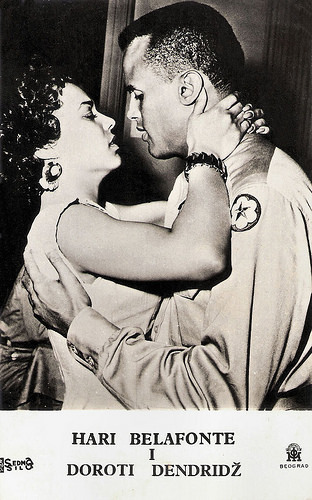
Yugoslavian postcard by IOM, Beograd. Photo: Sedmo Silo. Publicity still for Carmen Jones (Otto Preminger, 1954) with Harry Belafonte.
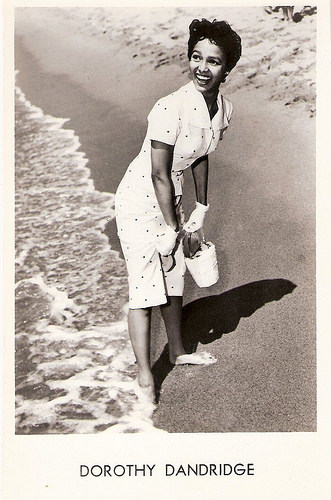
Vintage postcard, no. 2022.
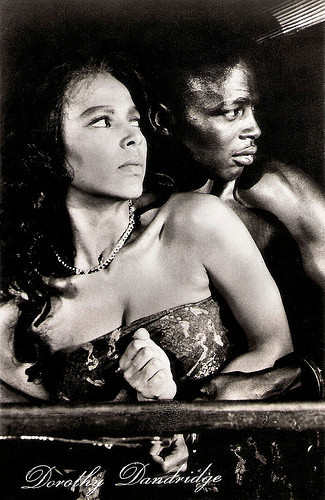
East-German postcard by VEB Progress Film-Vertrieb, Berlin, no. 1276, 1960. Photo: publicity still for Tamango (John Berry, 1958) with Alex Cresson.
An extremely intimate loving embrace
In 1957, after a three-year absence from film acting, Dorothy Dandridge agreed to appear in the film version of Island in the Sun (Robert Rossen, 1957), opposite an ensemble cast, including James Mason , Harry Belafonte, Joan Fontaine, Joan Collins , and Stephen Boyd.
Island in the Sun was controversial for its time, and the script was revised numerous times to accommodate the Production Code requirements about interracial relationships. There occurred, however, an extremely intimate loving embrace between Dandridge and John Justin that succeeded in not breaching the code. Despite the behind-the-scenes controversy and unfavorable critical reviews, the film was one of the year's biggest successes.
Dandridge next starred opposite Curd Jürgens in the Italian production of Tamango (John Berry, 1958). A reluctant Dandridge had agreed to appear in the film only after learning that it focused on a nineteenth century slave revolt on a cargo ship travelling from Africa to Cuba.
However, Dandridge nearly withdrew her involvement when the initial script called for her to swim in the nude and spend the majority of the film in a two-piece bathing suit made of rags. When Dandridge threatened to leave the film, the script and her wardrobe was retooled to her liking.
In 1959, she was nominated for a Golden Globe Award for Porgy and Bess (Otto Preminger, 1959). However, when the film was released, it was critically bashed and failed to recoup its financial investment.
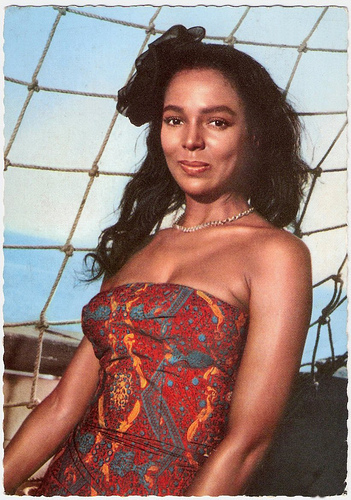
German postcard by Ufa (Universum-Film Aktiengesellschaft), Berlin-Tempelhof, no. CK-129. Retail price: 30 Pfg. Photo: Gerard Decaux. Publicity still for Tamango (John Berry, 1958).
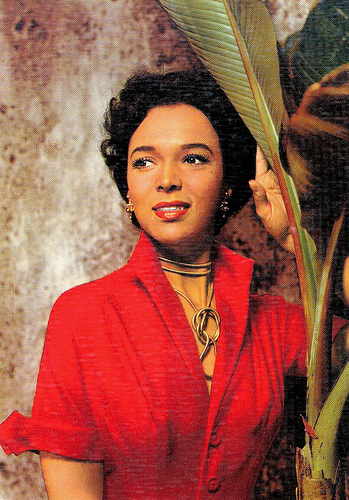
Italian postcard by Rotalfoto, Milano, no. 82.
Mysterious circumstances
Dorothy Dandridge next filmed a low-budget British thriller Malaga (László Benedek, 1960) in which she played a European woman with an Italian name. The film, co-starring Trevor Howard and Edmund Purdom , plotted a jewel robbery and its aftermath.
Howard and Dandridge created some strongly understated sexual tension in the film. Malanga was withheld from a theatrical release abroad until 1960, but went unreleased in the United States until 1962. It was her final completed film appearance.
Dandridge was married and divorced twice. From 1942 till 1951, she was married to dancer and entertainer Harold Nicholas of the Nicholas Brothers. They had a daughter, Harolyn Suzanne Nicholas, who was born brain-damaged.
In 1959 she married hotel owner Jack Denison. They divorced in 1962 amid financial setbacks and allegations of domestic violence. At this time, Dandridge discovered that the people who were handling her finances had swindled her out of $150,000 and that she was $139,000 in debt for back taxes.
In 1965, Dorothy Dandridge died under mysterious circumstances at the age of 42. She is the subject of the HBO biographical film, Introducing Dorothy Dandridge (Martha Coolidge, 1999) with Halle Berry.
Trailer Carmen Jones (Otto Preminger, 1954). Source: AgelessTrailers (YouTube).
Clip from Tamango (John Berry, 1958). Source: ClassicBlackCinema's channel (YouTube).
Sources: Wikipedia and .

German postcard by ISV. Photo: 20th Century Fox. Publicity still for Carmen Jones (Otto Preminger, 1954).

German postcard by Ufa, Berlin-Tempelhof, WP no. 14. Photo: Centfox.

Vintage photo.
The Wonder Children
Dorothy Jean Dandridge was born in, 1922 in Cleveland, Ohio, to Ruby Dandridge (née Ruby Jean Butler), an entertainer, and Cyril H. Dandridge, a cabinet maker and minister.
Under the prodding of her mother, Dorothy and her sister Vivian Dandridge began performing publicly, as the Wonder Children, later The Dandridge Sisters, usually in black Baptist churches throughout the country. Her mother would often join her daughters on stage.
During her early career, Dorothy appeared in a succession of films, usually in uncredited roles. Her film debut was a bit role in the Marx Brothers comedy, A Day at the Races (Sam Wood, 1937). She also performed as a vocalist in the Cotton Club and the Apollo Theater.
Her breakthrough was her title role in the all-black production of Carmen Jones (Otto Preminger, 1954). Dandridge's performance as the sultry title character made her one of Hollywood's first African-American sex symbols. Carmen Jones became a worldwide success, eventually earning over $10 million at the box office and becoming one of the year's highest-earning films.

Yugoslavian postcard by IOM, Beograd. Photo: Sedmo Silo. Publicity still for Carmen Jones (Otto Preminger, 1954) with Harry Belafonte.

Vintage postcard, no. 2022.

East-German postcard by VEB Progress Film-Vertrieb, Berlin, no. 1276, 1960. Photo: publicity still for Tamango (John Berry, 1958) with Alex Cresson.
An extremely intimate loving embrace
In 1957, after a three-year absence from film acting, Dorothy Dandridge agreed to appear in the film version of Island in the Sun (Robert Rossen, 1957), opposite an ensemble cast, including James Mason , Harry Belafonte, Joan Fontaine, Joan Collins , and Stephen Boyd.
Island in the Sun was controversial for its time, and the script was revised numerous times to accommodate the Production Code requirements about interracial relationships. There occurred, however, an extremely intimate loving embrace between Dandridge and John Justin that succeeded in not breaching the code. Despite the behind-the-scenes controversy and unfavorable critical reviews, the film was one of the year's biggest successes.
Dandridge next starred opposite Curd Jürgens in the Italian production of Tamango (John Berry, 1958). A reluctant Dandridge had agreed to appear in the film only after learning that it focused on a nineteenth century slave revolt on a cargo ship travelling from Africa to Cuba.
However, Dandridge nearly withdrew her involvement when the initial script called for her to swim in the nude and spend the majority of the film in a two-piece bathing suit made of rags. When Dandridge threatened to leave the film, the script and her wardrobe was retooled to her liking.
In 1959, she was nominated for a Golden Globe Award for Porgy and Bess (Otto Preminger, 1959). However, when the film was released, it was critically bashed and failed to recoup its financial investment.

German postcard by Ufa (Universum-Film Aktiengesellschaft), Berlin-Tempelhof, no. CK-129. Retail price: 30 Pfg. Photo: Gerard Decaux. Publicity still for Tamango (John Berry, 1958).

Italian postcard by Rotalfoto, Milano, no. 82.
Mysterious circumstances
Dorothy Dandridge next filmed a low-budget British thriller Malaga (László Benedek, 1960) in which she played a European woman with an Italian name. The film, co-starring Trevor Howard and Edmund Purdom , plotted a jewel robbery and its aftermath.
Howard and Dandridge created some strongly understated sexual tension in the film. Malanga was withheld from a theatrical release abroad until 1960, but went unreleased in the United States until 1962. It was her final completed film appearance.
Dandridge was married and divorced twice. From 1942 till 1951, she was married to dancer and entertainer Harold Nicholas of the Nicholas Brothers. They had a daughter, Harolyn Suzanne Nicholas, who was born brain-damaged.
In 1959 she married hotel owner Jack Denison. They divorced in 1962 amid financial setbacks and allegations of domestic violence. At this time, Dandridge discovered that the people who were handling her finances had swindled her out of $150,000 and that she was $139,000 in debt for back taxes.
In 1965, Dorothy Dandridge died under mysterious circumstances at the age of 42. She is the subject of the HBO biographical film, Introducing Dorothy Dandridge (Martha Coolidge, 1999) with Halle Berry.
Trailer Carmen Jones (Otto Preminger, 1954). Source: AgelessTrailers (YouTube).
Clip from Tamango (John Berry, 1958). Source: ClassicBlackCinema's channel (YouTube).
Sources: Wikipedia and .
Published on January 06, 2016 22:00
January 5, 2016
Michel Galabru (1922-2016)
Last Sunday, French actor Michel Galabru has died. He appeared in more than 250 films and worked with such directors as Bertrand Blier, Costa-Gavras, Luc Besson and Jean-Luc Godard. He is probably best known for his comedies with Louis de Funès.
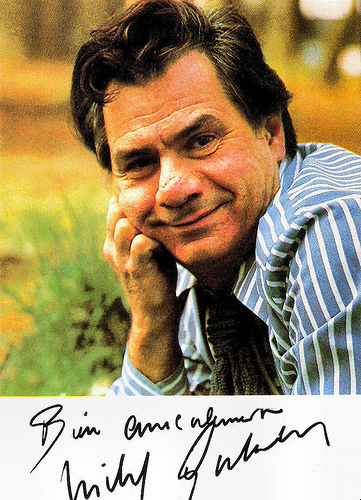
French postcard by La Roue Tourne, Paris.
Le gendarme de Saint-Tropez
Michel Louis Edmond Galabru was born in Safi, French Protectorate of Morocco (now Morocco) in 1922. He spent the first seven years of his life in Safi, where his engineer father was involved in the construction of the port city. Later, he studied at the Conservatoire national d'art dramatique in Paris.
In 1962, he played in the classic film La Guerre des boutons/War of the Buttons (Yves Robert, 1962) about two rival kid gangs whose playful combats escalate into violence. Galabru appears as the father of one of the kids.
The following year, he appeared with Michel Serrault and Louis de Funès in the comedy Nous irons à Deauville/We Will Go to Deauville (Francis Rigaud, 1963).
In the following decade, he became the sidekick of De Funès in a series of wildly popular farces about the police force of Saint-Tropez, a fashionable resort on the French Riviera: Le gendarme de Saint-Tropez/The Troops of St. Tropez (Jean Girault, 1964), Le gendarme à New York/Gendarme in New York (Jean Girault, 1965), Le gendarme se marie/The Gendarme Gets Married (Jean Girault, 1967), Le gendarme en balade/The gendarme to stroll (Jean Girault, 1970), Le Gendarme et Les Extra-Terrestres/The Gendarme and the Extra-Terrestrials (Jean Girault, 1979), and finally Le gendarme et les gendarmettes/The Gendarme and the Gendarmettes (Jean Girault, Tony Aboyantz, 1982).
In all these films, Galabru played command sergeant major Gerber. He also appeared in other comedies with De Funès, such as Le Petit Baigneur/The Little Bather (Robert Dhéry, 1968) and Jo/Joe: The Busy Body (Jean Girault, 1972).
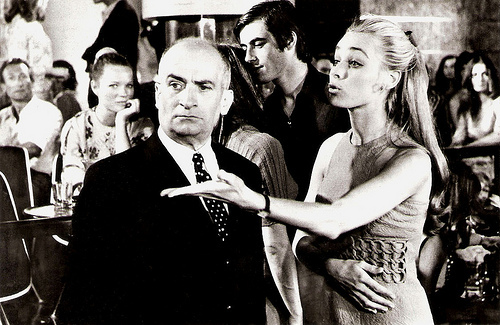
Romanian postcard by Casa Filmului Acin, no. 294. Retail price: 1,50 Lei. Photo: publicity shot for Le gendarme se marie/The Gendarme Gets Married (Jean Girault, 1968) with Louis de Funès and Geneviève Grad .
La Cage aux Folles
Michel Galabru appeared during his career in more than 250 films. In 1977, Galabru received a César for Best Actor for his portrayal of mass murderer Joseph Bouvier in Bertrand Tavernier's Le Juge et l'assassin/The Judge and the Assassin (1976) opposite Philippe Noiret .
He also worked with such prominent directors as Costa-Gavras for Section special/Special Section (1975), Bertrand Blier for Notre histoire/Our Story (1984), Luc Besson for Subway (1985), and Jean-Luc Godard for Soigne ta droite/Keep Your Right Up (1987).
Galabru kept appearing in popular comedies and played with Louis de Funès in the Moliere adaptation L’avare/The Miser (Louis de Funès, Jean Girault, 1980).
He also worked with Ugo Tognazzi and Michel Serrault on the hilarious drag queen farce La Cage aux Folles (Édouard Molinaro, 1978) and its sequels La Cage aux Folles II (Édouard Molinaro, 1980), and La cage aux folles 3 - 'Elles' se marient/La Cage aux Folles 3: The Wedding (Georges Lautner, 1985).
His later films include the drama Mon Homme/My Man (Bertrand Blier, 1996) with Anouk Grinberg, and Astérix & Obélix contre César/Asterix & Obelix Take On Caesar (Claude Zidi, 1999), the first feature of what went on to become a series of live-action films based on Goscinny and Uderzo's Astérix comics.
He also appeared in the drama Un poison violent/Love Like Poison (Katell Quillévéré, 2010) starring Clara Augarde and Lio. It won the Prix Jean Vigo in 2010.
Michel Galabru died on 4 January 2016 in Paris of natural causes. He was married twice and had four children, including actress Emmanuelle Galabru. At the time of his death he was involved in several new film projects, including Ouvert la nuit (Edouard Baer, 2016) in which he co-stars with Audrey Tatou.
Trailer for Le gendarme de Saint-Tropez/The Troops of St. Tropez (1964). Source: Kanal von STUTTGART/BW (YouTube).
Trailer for Un poison violent/Love Like Poison (2010). Source: PalaceFilms.
Sources: Wikipedia and .

French postcard by La Roue Tourne, Paris.
Le gendarme de Saint-Tropez
Michel Louis Edmond Galabru was born in Safi, French Protectorate of Morocco (now Morocco) in 1922. He spent the first seven years of his life in Safi, where his engineer father was involved in the construction of the port city. Later, he studied at the Conservatoire national d'art dramatique in Paris.
In 1962, he played in the classic film La Guerre des boutons/War of the Buttons (Yves Robert, 1962) about two rival kid gangs whose playful combats escalate into violence. Galabru appears as the father of one of the kids.
The following year, he appeared with Michel Serrault and Louis de Funès in the comedy Nous irons à Deauville/We Will Go to Deauville (Francis Rigaud, 1963).
In the following decade, he became the sidekick of De Funès in a series of wildly popular farces about the police force of Saint-Tropez, a fashionable resort on the French Riviera: Le gendarme de Saint-Tropez/The Troops of St. Tropez (Jean Girault, 1964), Le gendarme à New York/Gendarme in New York (Jean Girault, 1965), Le gendarme se marie/The Gendarme Gets Married (Jean Girault, 1967), Le gendarme en balade/The gendarme to stroll (Jean Girault, 1970), Le Gendarme et Les Extra-Terrestres/The Gendarme and the Extra-Terrestrials (Jean Girault, 1979), and finally Le gendarme et les gendarmettes/The Gendarme and the Gendarmettes (Jean Girault, Tony Aboyantz, 1982).
In all these films, Galabru played command sergeant major Gerber. He also appeared in other comedies with De Funès, such as Le Petit Baigneur/The Little Bather (Robert Dhéry, 1968) and Jo/Joe: The Busy Body (Jean Girault, 1972).

Romanian postcard by Casa Filmului Acin, no. 294. Retail price: 1,50 Lei. Photo: publicity shot for Le gendarme se marie/The Gendarme Gets Married (Jean Girault, 1968) with Louis de Funès and Geneviève Grad .
La Cage aux Folles
Michel Galabru appeared during his career in more than 250 films. In 1977, Galabru received a César for Best Actor for his portrayal of mass murderer Joseph Bouvier in Bertrand Tavernier's Le Juge et l'assassin/The Judge and the Assassin (1976) opposite Philippe Noiret .
He also worked with such prominent directors as Costa-Gavras for Section special/Special Section (1975), Bertrand Blier for Notre histoire/Our Story (1984), Luc Besson for Subway (1985), and Jean-Luc Godard for Soigne ta droite/Keep Your Right Up (1987).
Galabru kept appearing in popular comedies and played with Louis de Funès in the Moliere adaptation L’avare/The Miser (Louis de Funès, Jean Girault, 1980).
He also worked with Ugo Tognazzi and Michel Serrault on the hilarious drag queen farce La Cage aux Folles (Édouard Molinaro, 1978) and its sequels La Cage aux Folles II (Édouard Molinaro, 1980), and La cage aux folles 3 - 'Elles' se marient/La Cage aux Folles 3: The Wedding (Georges Lautner, 1985).
His later films include the drama Mon Homme/My Man (Bertrand Blier, 1996) with Anouk Grinberg, and Astérix & Obélix contre César/Asterix & Obelix Take On Caesar (Claude Zidi, 1999), the first feature of what went on to become a series of live-action films based on Goscinny and Uderzo's Astérix comics.
He also appeared in the drama Un poison violent/Love Like Poison (Katell Quillévéré, 2010) starring Clara Augarde and Lio. It won the Prix Jean Vigo in 2010.
Michel Galabru died on 4 January 2016 in Paris of natural causes. He was married twice and had four children, including actress Emmanuelle Galabru. At the time of his death he was involved in several new film projects, including Ouvert la nuit (Edouard Baer, 2016) in which he co-stars with Audrey Tatou.
Trailer for Le gendarme de Saint-Tropez/The Troops of St. Tropez (1964). Source: Kanal von STUTTGART/BW (YouTube).
Trailer for Un poison violent/Love Like Poison (2010). Source: PalaceFilms.
Sources: Wikipedia and .
Published on January 05, 2016 22:00
January 4, 2016
Annie de Reuver (1917-2016)
Dutch singer Annie de Reuver has passed away. In the 1940s and 1950s she was one of the most popular Lady crooners, first with the big band The Ramblers and later with The Skymasters. She also appeared in one of the few Dutch film productions of the war period, the short musical Wie gaat mee?/Who will join? (1942). Her biggest hit was the song Kijk eens in de poppetjes van mijn ogen (Look into the puppets of my eyes). She was 98.
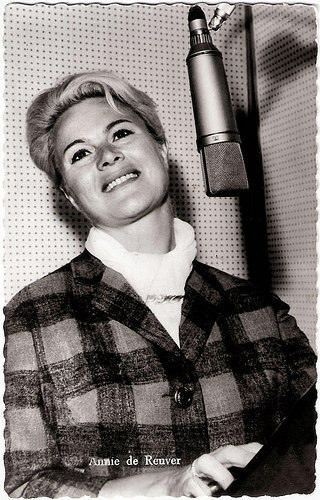
Dutch postcard, no. 962. Photo: Imperial.
Who will join?
Anna Maria Clasina de Reuver was born in Rotterdam, the Netherlands, in 1917. Annie inherited her love of music from his mother's side. During her school years she started with two boys the musical trio The Rhythm Aces. Then she sang with amateur big band The Blue Blowers.
De Reuver made her debut with the popular big band The Ramblers in 1934. She was nearly eighteen years old when De Reuver auditioned for conductor Theo Uden Masman and was accepted. Soon she was heard live on national radio broadcasts. In 1935 De Reuver joined The Ramblers and the American tenor saxophonist Coleman Hawkins to make recordings for Decca.
During the war period, De Reuver sang Dutch songs with several orchestras, despite the prevailing dance ban imposed by the occupying forces. She performed with such contemporary singers as Teddy Scholten and Thom Kelling. She also appeared in one of the few Dutch film productions of the war period, the short musical Wie gaat mee?/Who will join? (Reinier J. Meyer, 1942). After she had refused to become a member of the Nederlandse Kultuurkamer (the Nazi driven Dutch Chamber of Culture) in 1944, she could not perform anymore.
After the war De Reuver sang with several orchestras at home and abroad. She was often on the road but got homesick. When trombonist Pi Scheffer founded The Skymasters in 1946, De Reuver joined this orchestra. From 1947 to 1949 she lived in Venezuela, where her then husband led a Philips division. Then she returned to The Skymasters. In total, she would sing five years with the orchestra, with three performances per week for the radio.
De Reuver was best known for such songs as Harmonica Jim, Wenen (Vienna), Lied van het Pierement (Song of the Pierement), Veel bittere tranen (Many bitter tears), Diep in mijn hart (Deep in my heart) and Kijk eens in de poppetjes van mijn ogen (Look into the puppets of my eyes). The last one she recorded for the first time in 1952 as a duet with Karel van der Velden and The Skymasters.
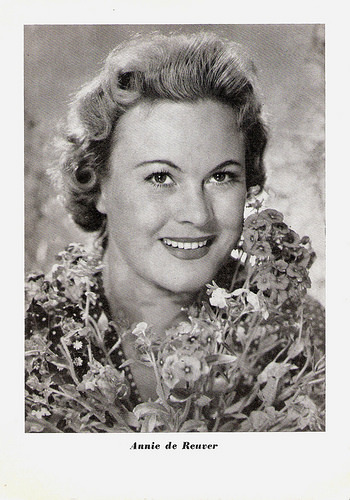
Big Dutch card.
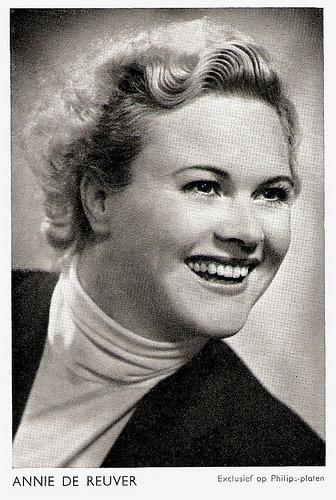
Dutch card. Photo: Philips.
Candidly
In the 1960s, Annie de Reuver often performed with the orchestra De Reuvertjes. She did tours for Dutch soldiers in the Netherlands, Germany and on ships. For years, she also sang twice a week on the radio. She often performed with contemporary artist Eddy Christiani. Around 1955, Christiani and De Reuver were repeatedly voted best Dutch vocalists by the leading Dutch magazine Tuney Tunes.
In 1968 she started as a record producer for Dureco in Amsterdam. De Reuver was quite successful in discovering and guiding Dutch talent. She spotted such artists as Oscar Harris, the Kermisklanten and Ben Cramer. For the latter, she produced his first hit: Zai Zai Zai (1967). She also discovered singer and producer Pierre Kartner a.k.a. Vader Abraham. Kartner and De Reuver recorded songs together as the Duo X.
In the early 1970s De Reuver moved to CNR Records, and later to record company Telstar. There she also discovered and promoted new talent. On a freelance basis, De Reuver also was a juror in TV talent shows at NCRV television. She later presented several radio shows.
In her seventieth, De Reuver produced the hit Kleine Jodeljongen (Little Jodel Boy, 1987) by Manke Nelis for Dureco, now as a freelancer. She occasionally appeared in nostalgic radio programs. In 1994 De Reuver received a royal decoration and the Erasmusspeld of the municipality of Rotterdam.
In 2005, the 88-years-old De Reuver performed in the Luxor Theater in Rotterdam on the occasion of 60th anniversary of the Day of Independence. To celebrate her 90th birthday, she published her book Onverbloemd (Candidly, 2007). This biography, written by journalist Rein Wolters, describes her life and career.
Annie de Reuver died as a result of complications after a fall. Actor Bas van Toor, a good friend of De Reuver, discovered she had fallen when he came to bring her donuts on New Year's Eve. The singer was still in surgery, but died a day later in her hometown Rotterdam. Annie de Reuver would have been 99 in February. She married and divorced four times and had no children.
Annie de Reuver sings Kijk Eens In De Poppetjes Van Mijn Ogen. Source: Diego Jiménez van der Rijst (YouTube).
News item on RTV Rijnmond. Source: rtvrijnmond (YouTube).
Sources: RTV Rijnmond (Dutch), Cinema en Theater (Dutch), Wikipedia (Dutch), and .

Dutch postcard, no. 962. Photo: Imperial.
Who will join?
Anna Maria Clasina de Reuver was born in Rotterdam, the Netherlands, in 1917. Annie inherited her love of music from his mother's side. During her school years she started with two boys the musical trio The Rhythm Aces. Then she sang with amateur big band The Blue Blowers.
De Reuver made her debut with the popular big band The Ramblers in 1934. She was nearly eighteen years old when De Reuver auditioned for conductor Theo Uden Masman and was accepted. Soon she was heard live on national radio broadcasts. In 1935 De Reuver joined The Ramblers and the American tenor saxophonist Coleman Hawkins to make recordings for Decca.
During the war period, De Reuver sang Dutch songs with several orchestras, despite the prevailing dance ban imposed by the occupying forces. She performed with such contemporary singers as Teddy Scholten and Thom Kelling. She also appeared in one of the few Dutch film productions of the war period, the short musical Wie gaat mee?/Who will join? (Reinier J. Meyer, 1942). After she had refused to become a member of the Nederlandse Kultuurkamer (the Nazi driven Dutch Chamber of Culture) in 1944, she could not perform anymore.
After the war De Reuver sang with several orchestras at home and abroad. She was often on the road but got homesick. When trombonist Pi Scheffer founded The Skymasters in 1946, De Reuver joined this orchestra. From 1947 to 1949 she lived in Venezuela, where her then husband led a Philips division. Then she returned to The Skymasters. In total, she would sing five years with the orchestra, with three performances per week for the radio.
De Reuver was best known for such songs as Harmonica Jim, Wenen (Vienna), Lied van het Pierement (Song of the Pierement), Veel bittere tranen (Many bitter tears), Diep in mijn hart (Deep in my heart) and Kijk eens in de poppetjes van mijn ogen (Look into the puppets of my eyes). The last one she recorded for the first time in 1952 as a duet with Karel van der Velden and The Skymasters.

Big Dutch card.

Dutch card. Photo: Philips.
Candidly
In the 1960s, Annie de Reuver often performed with the orchestra De Reuvertjes. She did tours for Dutch soldiers in the Netherlands, Germany and on ships. For years, she also sang twice a week on the radio. She often performed with contemporary artist Eddy Christiani. Around 1955, Christiani and De Reuver were repeatedly voted best Dutch vocalists by the leading Dutch magazine Tuney Tunes.
In 1968 she started as a record producer for Dureco in Amsterdam. De Reuver was quite successful in discovering and guiding Dutch talent. She spotted such artists as Oscar Harris, the Kermisklanten and Ben Cramer. For the latter, she produced his first hit: Zai Zai Zai (1967). She also discovered singer and producer Pierre Kartner a.k.a. Vader Abraham. Kartner and De Reuver recorded songs together as the Duo X.
In the early 1970s De Reuver moved to CNR Records, and later to record company Telstar. There she also discovered and promoted new talent. On a freelance basis, De Reuver also was a juror in TV talent shows at NCRV television. She later presented several radio shows.
In her seventieth, De Reuver produced the hit Kleine Jodeljongen (Little Jodel Boy, 1987) by Manke Nelis for Dureco, now as a freelancer. She occasionally appeared in nostalgic radio programs. In 1994 De Reuver received a royal decoration and the Erasmusspeld of the municipality of Rotterdam.
In 2005, the 88-years-old De Reuver performed in the Luxor Theater in Rotterdam on the occasion of 60th anniversary of the Day of Independence. To celebrate her 90th birthday, she published her book Onverbloemd (Candidly, 2007). This biography, written by journalist Rein Wolters, describes her life and career.
Annie de Reuver died as a result of complications after a fall. Actor Bas van Toor, a good friend of De Reuver, discovered she had fallen when he came to bring her donuts on New Year's Eve. The singer was still in surgery, but died a day later in her hometown Rotterdam. Annie de Reuver would have been 99 in February. She married and divorced four times and had no children.
Annie de Reuver sings Kijk Eens In De Poppetjes Van Mijn Ogen. Source: Diego Jiménez van der Rijst (YouTube).
News item on RTV Rijnmond. Source: rtvrijnmond (YouTube).
Sources: RTV Rijnmond (Dutch), Cinema en Theater (Dutch), Wikipedia (Dutch), and .
Published on January 04, 2016 22:00
January 3, 2016
Olga Tschechova
Dignified German-Russian actress Olga Tschechova (1897-1980) was one of the most popular stars of the German silent cinema. During the following decades, she became the 'Grande Dame of German Film'. She remained a mysterious person throughout her life, and reportedly, she was a Russian agent in Nazi Germany.
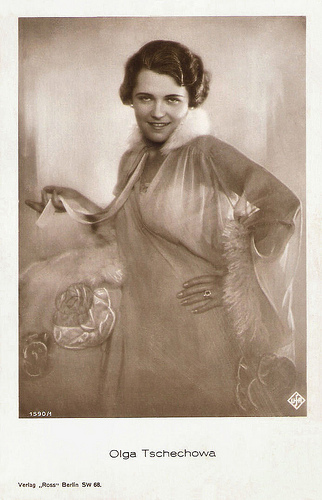
German postcard by Ross Verlag, Berlin, no. 1590/1, 1927-1928. Photo: Ufa.
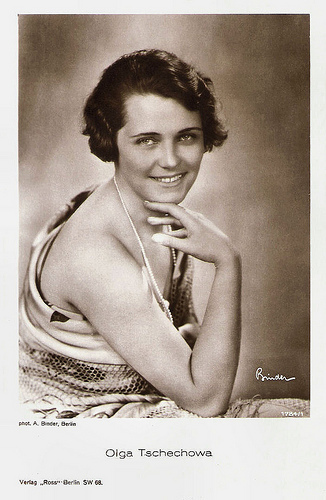
German postcard by Ross Verlag, Berlin, no. 1784/1, 1927-1928. Photo: Alex Binder.
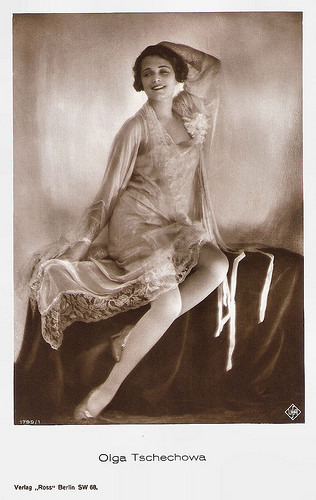
German postcard by Ross Verlag, Berlin, no. 1799/1, 1927-1928. Photo: Ufa.
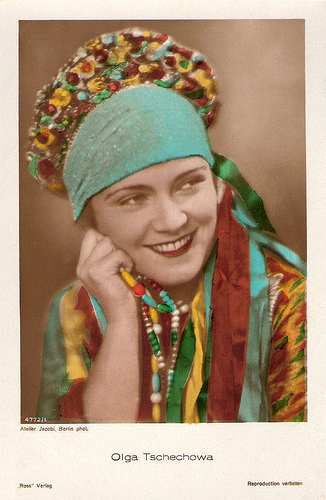
German postcard by Ross Verlag, no. 4772/1, 1929-1930. Photo: Atelier Jacobi, Berlin.
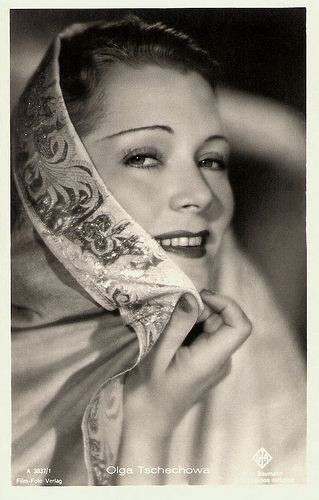
German postcard by Ross-Verlag, no. A 3837/1, 1941-1944. Photo: Baumann / Ufa.
The Niece of Anton Chekhov's Wife
Olga Tschechova - or in Russian Olga Chekhova and in German Olga Tschechowa - was born Olga Konstantinovna Von Knipper in Alexandropol, Russian Empire (now Gyumri, Armenia), in 1897. She was the second of three children in a wealthy bilingual Russian-German family.
Her father, Konstantin Knipper, was a military railroad engineer. Her family had very good contacts to the court of the Czar. Olga studied sculpture at the St. Peterburg Academy of Arts. Then was sent to Moscow to her aunt, actress Olga Knipper, Anton Chekhov’s wife, and joined a studio of the Moscow Art Theatre.
In 1914, at the age of 17 she married the Russian-Jewish actor Mikhail (Michael) Chekhov, a rising star of stage and film. He was a nephew of Anton Chekhov. (Thus, the niece of Anton Chekhov's wife became the wife of Anton Chekhov's nephew.)
Their daughter, Ada Tschechowa was born in 1916. Olga separated from Michael Chekhov during the chaos and disaster of the Russian Revolution in 1917. Michael had met another beauty, Xenia Zimmer, and became involved in extramarital affair while Olga was pregnant with their child.
That same year she made her film debut in a Russian silent film Anya Kraeva (Nikandr Turkin, 1917). More small parts followed in the films Kaliostro/Cagliostro (Wladyslaw Starewicz, 1918), and Posledeniye priklyucheniya Arsena Lyupena/Arsène Lupin's Last Adventures (Mikhail Doronin, 1918). In these films she was credited as Olga Chekhova.
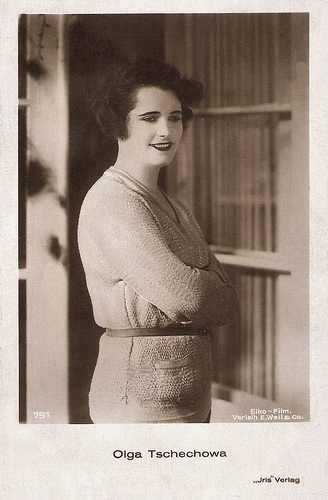
Austrian postcard by Iris-Verlag, nr. 791. Photo: Eiko-Film/Verleih E. Weil & Co.
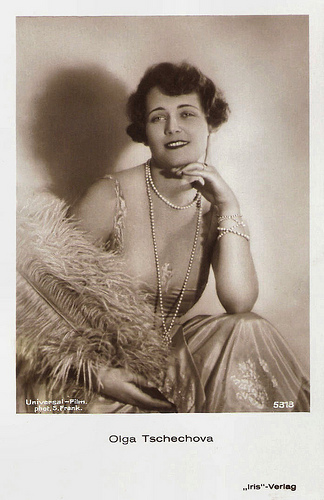
Austrian postcard by Iris-Verlag, no. 5313. Photo: S. Frank / Universal-Film.
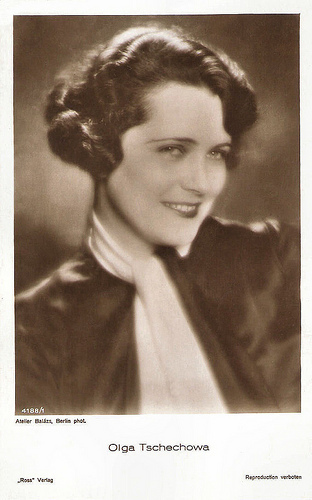
German postcard by Ross-Verlag, no. 4188/1, 1929-1930. Photo: Atelier Balázs, Berlin.
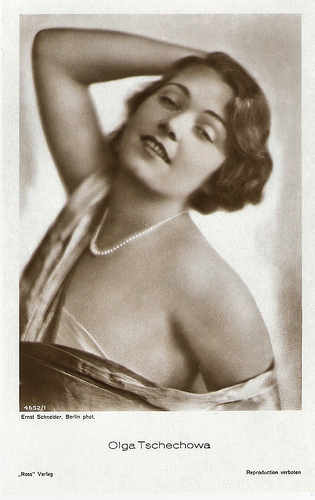
German postcard by Ross Verlag no. 4652/1, 1929-1930. Photo: Ernst Schneider, Berlin.
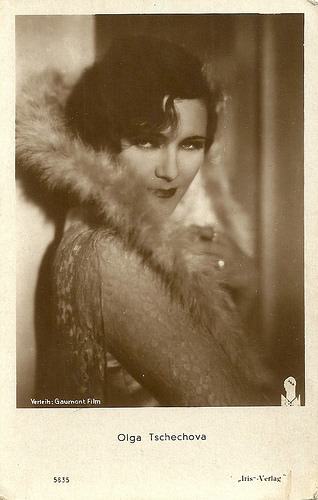
Austrian postcard by Iris-Verlag, no. 5835. Photo: Dist. Gaumont Film / Nero-Film.
Blonde and Beautiful
In 1920, Olga Tschechova married an Austro-Hungarian officer, Friedrich Jaroshi, and took a train to Vienna, Austria. She had travel documents from the Russian government Commissar of Culture, and was helped by the secret service in exchange for cooperation.
Later that year she moved to Berlin, where she was introduced to Ufa producer Erich Pommer, who gave her a leading role as a baroness in Schloss Vogelöd/The Haunted Castle (F.W. Murnau, 1921).
The blonde and beautiful actress also appeared in films like the Henrik Ibsen adaptation Nora (Berthold Viertel, 1923) with Fritz Kortner , and Tatjana (Robert Dinesen, 1923) with Paul Hartmann .
Tschechova managed her breakthrough with her performance as a seductress and Grande Dame in Die Stadt der Versuchung/The City of Temptation (Walter Niebuhr, 1925).
She quickly became a huge star in Europe and played in more than 40 silent films during the decade, including the classic comedy Un Chapeau de Paille d'Italie/An Italian Straw Hat (René Clair, 1927), Moulin Rouge (Ewald André Dupont, 1928), and Diane (Erich Waschneck, 1929), which was produced by her own company Tschechowa Film.
Olga was joined by her ex-husband Michael Chekhov in several films, including Der Narr Seine Liebe/The Fool of Love (1929), which she directed herself. In spite of the positive reviews this would be her only direction.
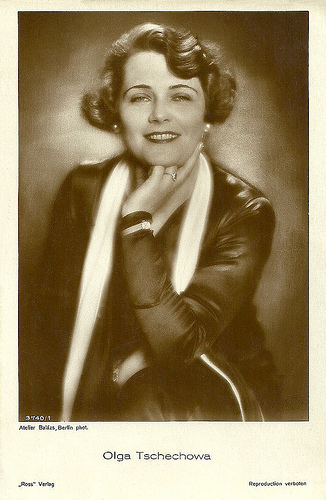
German postcard by Ross Verlag, no. 3740/1, 1928-1929. Photo: Atelier Balazs, Berlin.
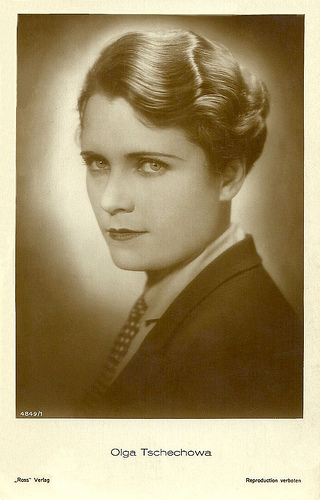
German postcard by Ross Verlag, no. 4849/1, 1929-1930.
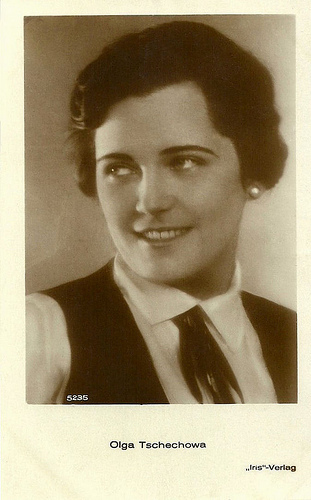
Austrian postcard by Iris Verlag, no. 5235, 1927-1928.
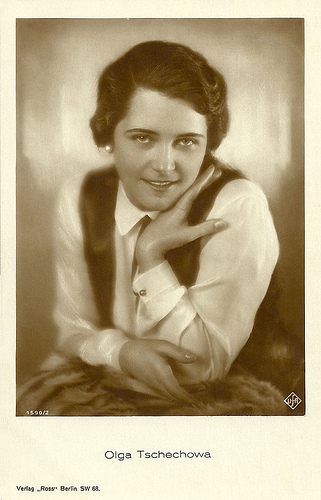
German postcard by Ross Verlag, no. 1590/2, 1927-1928. Photo: Ufa.
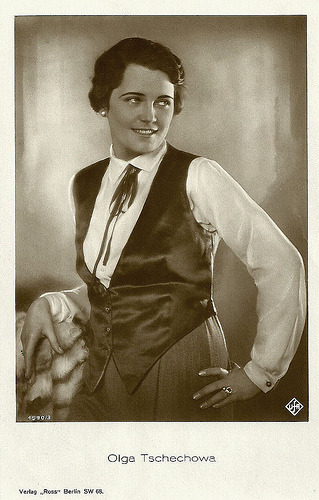
German postcard by Ross Verlag, no. 1590/3, 1927-1928. Photo: Ufa.
Hitchcock
In 1930 Olga Tschechova became a German citizen. She continued her career successfully in the sound film era in Liebe im Ring/Love in the Ring (Reinhold Schünzel, 1930), the incredibly popular Die Drei von der Tankstelle/The Three From the Gas Station (Wilhelm Thiele, 1930), and Liebling der Götter/Darling of the Gods (Hanns Schwarz, 1930), and the German version of Alfred Hitchcock’s thriller Murder, Mary (Alfred Hitchcock, 1931).
The following year Tschechova did the German-language version of The Boudoir Diplomat (Malcolm St. Clair, 1932) in Hollywood but she preferred to work in Europe. She earned the best reviews of her long career for Max Ophüls' early masterpiece Liebelei/Flirtation (1933). It was made shortly before the Nazis took over control of the German film industry and nothing would ever be the same again.
Although apolitical and quite publicly expressing her fondness for American-style comedies and musicals, Tschechova could not escape appearing in several of the so-called Friedrich-Filme, heavy-handed sturm-und-drang melodramas glorifying 18th century Prussian ruler Frederick the Great and much beloved by the political hierarchy.
To her better films of the 1930s belong Ein gewisser Herr Gran/A Certain Mr. Gran (Gerhard Lamprecht, 1933) with Hans Albers, the delightful Maskerade/Masquerade in Vienna (Willi Forst, 1934), Die Ewige Maske/The Eternal Mask (Werner Hochbaum, 1935), Burgtheater/Burg Theatre (Willi Forst, 1936), and Bel Ami (Willi Forst, 1939).
She was famous for her film image as a baroness or a countess. Olga was courted by the Luftwaffe boss Hermann Göring and by Propaganda Minister Josef Goebbels, and became a personal friend of Adolf Hitler. She was photographed sitting next to the Fuhrer at official events of the Nazi Party. In 1936 she was honoured with the title of State Actress of the Third Reich.
She married a wealthy Belgian businessman Marcel Robyns, but two years later she divorced him and returned to her high society life in Berlin. In the 1940s followed well-known productions like Der Fuchs von Glenarvon/The Fox of Glenarvon (Max W. Kimmich, 1940), and Andreas Schlüter (Herbert Maisch, 1942).
She survived and protected her daughter Ada Tschechova from the Nazi anti-Semitism, by hiding the fact that her ex-husband Michael Chekhov was Jewish. Her brother Lev Knipper was held in a Nazi concentration camp and he probably also managed to survive because of her help. During the battle of Berlin, Olga hid in a bomb shelter and was seized by the Red Army.
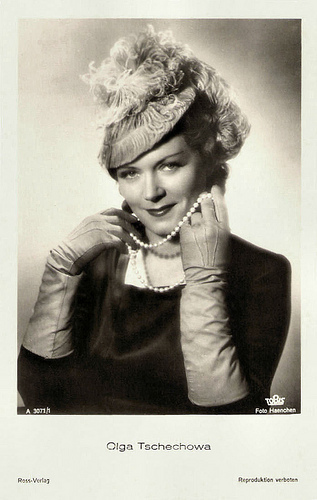
German postcard by Ross-Verlag, no. A 3071/1, 1941-1944. Photo: Haenchen / Tobis.
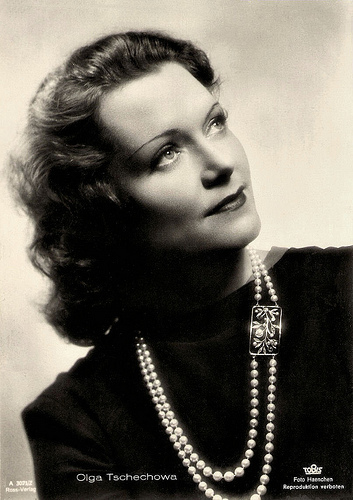
German postcard by Ross Verlag, no. A 3071/2, 1941-1944. Photo: Haenchen / Tobis.
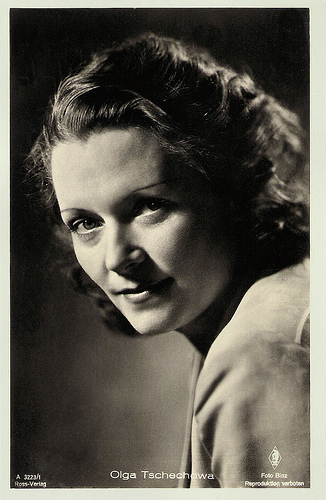
German postcard by Ross Verlag, Berlin, no. A 3223/1, 1941-1944. Photo: Binz.
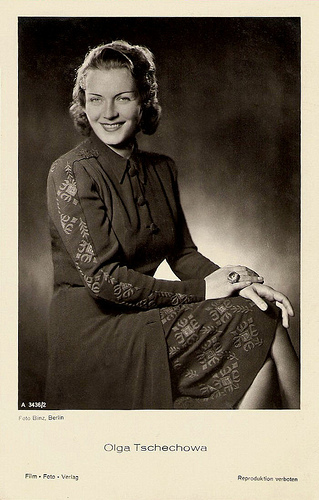
German postcard by Film-Foto-Verlag, no. A 3436/2, 1941-1944. Photo: Binz, Berlin.
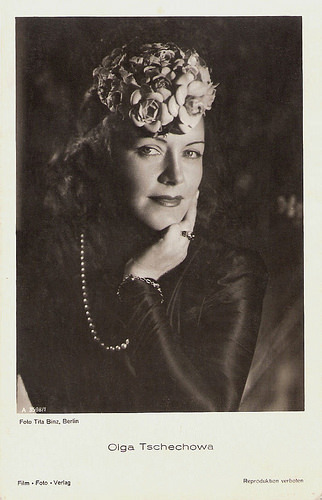
German postcard by Film-Foto-Verlag, Berlin, no. A 3598/1, 1941-1944. Photo: Tita Binz, Berlin.
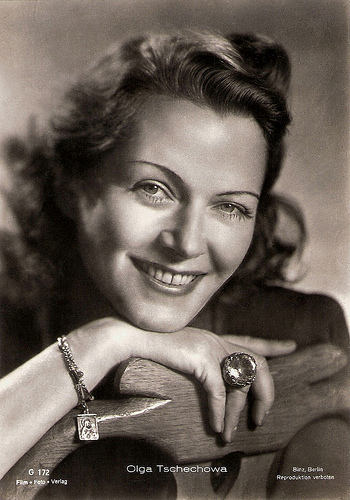
German postcard by Film-Foto-Verlag, no. G 172. Photo: Binz, Berlin. From Tatiana.
Life Is Beautiful
After the war Olga Tschechova lived in the Soviet sector of Berlin. French and British press reports stated that Olga Tschechova was a clandestine agent and was secretly decorated by the Soviet government. Eventually she managed to escape from her Soviet contacts and in 1949, she moved to Munich, Bavaria.
She played in such films as Aufruhr im Paradies/Incognito in Paradise (Joe Stöckl, 1950), Alles für Papa/Everything for Dad (Karl Hartl, 1953), Rosen-Resli/Rose-Girl Resli (Harald Reinl, 1954), Ich war ein häßliches Mädchen/I was an Ugly Girl (Wolfgang Liebeneiner, 1955), and U 47 - Kapitänleutnant Prien/U-47 Lt. Commander Prien (Harald Reinl, 1958).
In 1955 she launched a successful cosmetics company, Olga Tscheschowa Kosmetik Geselschaft and at the end of the 1950s she retired from the film business. In 1966, Olga's only daughter Ada died in an airplane crash. Devastated by the painful loss, Olga suffered from bouts of depression and turned to alcohol, but she survived thanks to her strong will and lust for life.
In the 1970s, she had a short comeback in the cinema. A chance to work with her famous granddaughter Vera Tschechova led to an appearance in the TV series Duell zu Dritt/Duel for Three (1971). Roles followed in the films Die Zwillinge vom Immenhof/Twins from Immen Farm (Wolfgang Schleif, 1973) and finally Frühling auf Immenhof/Springtime for Immen Farm (Wolfgang Schleif, 1974). Her remarkable acting career, spanning almost 60 years, ended with a small film role as a grandmother.
She published her memoirs. According to the book Killing Hitler (2006), by the British author Roger Moorhouse, Tschechova was pressured by Stalin and Beria to flirt with Adolf Hitler in order to gain and transfer information so that Hitler could be killed by secret Soviet agents. In her own book, Tschechova she wrote about her good contacts to the leading Nazis but she denied activities as an agent.
Moments before Olga Tschechova died in 1980 in Munich-Obermenzing, Germany, she ordered a glass of champagne from her granddaughter Vera Tschechowa , sensing the end was near. Her last words were: “Life is beautiful!” She was 82. Her correspondence with Russian actors Olga Knipper and Alla Tarasova was published posthumously.
Scenes from Moulin Rouge (Ewald André Dupont, 1928) with Jean Bradin. Source: Radiosantos (YouTube).
Mary (Alfred Hitchcock, 1931) - complete film. Source: CINENET Deutschland (YouTube).
Olga Tschechova and Lilian Harvey sing Erst kommt ein großes Fragezeichen/First Comes A Big Question Mark in Die Drei von der Tankstelle/The Three From the Gas Station (1930). Source: EinLiedgehtumdieWelt (YouTube).
The final scene from Die Drei von der Tankstelle/The Three From the Gas Station (1930). Source: EinLiedgehtumdieWelt (YouTube).
Tschechova sings Die Liebe ist ja nur ein Spiel in Regine (1934). Source: Alparfan (YouTube).
Sources:

German postcard by Ross Verlag, Berlin, no. 1590/1, 1927-1928. Photo: Ufa.

German postcard by Ross Verlag, Berlin, no. 1784/1, 1927-1928. Photo: Alex Binder.

German postcard by Ross Verlag, Berlin, no. 1799/1, 1927-1928. Photo: Ufa.

German postcard by Ross Verlag, no. 4772/1, 1929-1930. Photo: Atelier Jacobi, Berlin.

German postcard by Ross-Verlag, no. A 3837/1, 1941-1944. Photo: Baumann / Ufa.
The Niece of Anton Chekhov's Wife
Olga Tschechova - or in Russian Olga Chekhova and in German Olga Tschechowa - was born Olga Konstantinovna Von Knipper in Alexandropol, Russian Empire (now Gyumri, Armenia), in 1897. She was the second of three children in a wealthy bilingual Russian-German family.
Her father, Konstantin Knipper, was a military railroad engineer. Her family had very good contacts to the court of the Czar. Olga studied sculpture at the St. Peterburg Academy of Arts. Then was sent to Moscow to her aunt, actress Olga Knipper, Anton Chekhov’s wife, and joined a studio of the Moscow Art Theatre.
In 1914, at the age of 17 she married the Russian-Jewish actor Mikhail (Michael) Chekhov, a rising star of stage and film. He was a nephew of Anton Chekhov. (Thus, the niece of Anton Chekhov's wife became the wife of Anton Chekhov's nephew.)
Their daughter, Ada Tschechowa was born in 1916. Olga separated from Michael Chekhov during the chaos and disaster of the Russian Revolution in 1917. Michael had met another beauty, Xenia Zimmer, and became involved in extramarital affair while Olga was pregnant with their child.
That same year she made her film debut in a Russian silent film Anya Kraeva (Nikandr Turkin, 1917). More small parts followed in the films Kaliostro/Cagliostro (Wladyslaw Starewicz, 1918), and Posledeniye priklyucheniya Arsena Lyupena/Arsène Lupin's Last Adventures (Mikhail Doronin, 1918). In these films she was credited as Olga Chekhova.

Austrian postcard by Iris-Verlag, nr. 791. Photo: Eiko-Film/Verleih E. Weil & Co.

Austrian postcard by Iris-Verlag, no. 5313. Photo: S. Frank / Universal-Film.

German postcard by Ross-Verlag, no. 4188/1, 1929-1930. Photo: Atelier Balázs, Berlin.

German postcard by Ross Verlag no. 4652/1, 1929-1930. Photo: Ernst Schneider, Berlin.

Austrian postcard by Iris-Verlag, no. 5835. Photo: Dist. Gaumont Film / Nero-Film.
Blonde and Beautiful
In 1920, Olga Tschechova married an Austro-Hungarian officer, Friedrich Jaroshi, and took a train to Vienna, Austria. She had travel documents from the Russian government Commissar of Culture, and was helped by the secret service in exchange for cooperation.
Later that year she moved to Berlin, where she was introduced to Ufa producer Erich Pommer, who gave her a leading role as a baroness in Schloss Vogelöd/The Haunted Castle (F.W. Murnau, 1921).
The blonde and beautiful actress also appeared in films like the Henrik Ibsen adaptation Nora (Berthold Viertel, 1923) with Fritz Kortner , and Tatjana (Robert Dinesen, 1923) with Paul Hartmann .
Tschechova managed her breakthrough with her performance as a seductress and Grande Dame in Die Stadt der Versuchung/The City of Temptation (Walter Niebuhr, 1925).
She quickly became a huge star in Europe and played in more than 40 silent films during the decade, including the classic comedy Un Chapeau de Paille d'Italie/An Italian Straw Hat (René Clair, 1927), Moulin Rouge (Ewald André Dupont, 1928), and Diane (Erich Waschneck, 1929), which was produced by her own company Tschechowa Film.
Olga was joined by her ex-husband Michael Chekhov in several films, including Der Narr Seine Liebe/The Fool of Love (1929), which she directed herself. In spite of the positive reviews this would be her only direction.

German postcard by Ross Verlag, no. 3740/1, 1928-1929. Photo: Atelier Balazs, Berlin.

German postcard by Ross Verlag, no. 4849/1, 1929-1930.

Austrian postcard by Iris Verlag, no. 5235, 1927-1928.

German postcard by Ross Verlag, no. 1590/2, 1927-1928. Photo: Ufa.

German postcard by Ross Verlag, no. 1590/3, 1927-1928. Photo: Ufa.
Hitchcock
In 1930 Olga Tschechova became a German citizen. She continued her career successfully in the sound film era in Liebe im Ring/Love in the Ring (Reinhold Schünzel, 1930), the incredibly popular Die Drei von der Tankstelle/The Three From the Gas Station (Wilhelm Thiele, 1930), and Liebling der Götter/Darling of the Gods (Hanns Schwarz, 1930), and the German version of Alfred Hitchcock’s thriller Murder, Mary (Alfred Hitchcock, 1931).
The following year Tschechova did the German-language version of The Boudoir Diplomat (Malcolm St. Clair, 1932) in Hollywood but she preferred to work in Europe. She earned the best reviews of her long career for Max Ophüls' early masterpiece Liebelei/Flirtation (1933). It was made shortly before the Nazis took over control of the German film industry and nothing would ever be the same again.
Although apolitical and quite publicly expressing her fondness for American-style comedies and musicals, Tschechova could not escape appearing in several of the so-called Friedrich-Filme, heavy-handed sturm-und-drang melodramas glorifying 18th century Prussian ruler Frederick the Great and much beloved by the political hierarchy.
To her better films of the 1930s belong Ein gewisser Herr Gran/A Certain Mr. Gran (Gerhard Lamprecht, 1933) with Hans Albers, the delightful Maskerade/Masquerade in Vienna (Willi Forst, 1934), Die Ewige Maske/The Eternal Mask (Werner Hochbaum, 1935), Burgtheater/Burg Theatre (Willi Forst, 1936), and Bel Ami (Willi Forst, 1939).
She was famous for her film image as a baroness or a countess. Olga was courted by the Luftwaffe boss Hermann Göring and by Propaganda Minister Josef Goebbels, and became a personal friend of Adolf Hitler. She was photographed sitting next to the Fuhrer at official events of the Nazi Party. In 1936 she was honoured with the title of State Actress of the Third Reich.
She married a wealthy Belgian businessman Marcel Robyns, but two years later she divorced him and returned to her high society life in Berlin. In the 1940s followed well-known productions like Der Fuchs von Glenarvon/The Fox of Glenarvon (Max W. Kimmich, 1940), and Andreas Schlüter (Herbert Maisch, 1942).
She survived and protected her daughter Ada Tschechova from the Nazi anti-Semitism, by hiding the fact that her ex-husband Michael Chekhov was Jewish. Her brother Lev Knipper was held in a Nazi concentration camp and he probably also managed to survive because of her help. During the battle of Berlin, Olga hid in a bomb shelter and was seized by the Red Army.

German postcard by Ross-Verlag, no. A 3071/1, 1941-1944. Photo: Haenchen / Tobis.

German postcard by Ross Verlag, no. A 3071/2, 1941-1944. Photo: Haenchen / Tobis.

German postcard by Ross Verlag, Berlin, no. A 3223/1, 1941-1944. Photo: Binz.

German postcard by Film-Foto-Verlag, no. A 3436/2, 1941-1944. Photo: Binz, Berlin.

German postcard by Film-Foto-Verlag, Berlin, no. A 3598/1, 1941-1944. Photo: Tita Binz, Berlin.

German postcard by Film-Foto-Verlag, no. G 172. Photo: Binz, Berlin. From Tatiana.
Life Is Beautiful
After the war Olga Tschechova lived in the Soviet sector of Berlin. French and British press reports stated that Olga Tschechova was a clandestine agent and was secretly decorated by the Soviet government. Eventually she managed to escape from her Soviet contacts and in 1949, she moved to Munich, Bavaria.
She played in such films as Aufruhr im Paradies/Incognito in Paradise (Joe Stöckl, 1950), Alles für Papa/Everything for Dad (Karl Hartl, 1953), Rosen-Resli/Rose-Girl Resli (Harald Reinl, 1954), Ich war ein häßliches Mädchen/I was an Ugly Girl (Wolfgang Liebeneiner, 1955), and U 47 - Kapitänleutnant Prien/U-47 Lt. Commander Prien (Harald Reinl, 1958).
In 1955 she launched a successful cosmetics company, Olga Tscheschowa Kosmetik Geselschaft and at the end of the 1950s she retired from the film business. In 1966, Olga's only daughter Ada died in an airplane crash. Devastated by the painful loss, Olga suffered from bouts of depression and turned to alcohol, but she survived thanks to her strong will and lust for life.
In the 1970s, she had a short comeback in the cinema. A chance to work with her famous granddaughter Vera Tschechova led to an appearance in the TV series Duell zu Dritt/Duel for Three (1971). Roles followed in the films Die Zwillinge vom Immenhof/Twins from Immen Farm (Wolfgang Schleif, 1973) and finally Frühling auf Immenhof/Springtime for Immen Farm (Wolfgang Schleif, 1974). Her remarkable acting career, spanning almost 60 years, ended with a small film role as a grandmother.
She published her memoirs. According to the book Killing Hitler (2006), by the British author Roger Moorhouse, Tschechova was pressured by Stalin and Beria to flirt with Adolf Hitler in order to gain and transfer information so that Hitler could be killed by secret Soviet agents. In her own book, Tschechova she wrote about her good contacts to the leading Nazis but she denied activities as an agent.
Moments before Olga Tschechova died in 1980 in Munich-Obermenzing, Germany, she ordered a glass of champagne from her granddaughter Vera Tschechowa , sensing the end was near. Her last words were: “Life is beautiful!” She was 82. Her correspondence with Russian actors Olga Knipper and Alla Tarasova was published posthumously.
Scenes from Moulin Rouge (Ewald André Dupont, 1928) with Jean Bradin. Source: Radiosantos (YouTube).
Mary (Alfred Hitchcock, 1931) - complete film. Source: CINENET Deutschland (YouTube).
Olga Tschechova and Lilian Harvey sing Erst kommt ein großes Fragezeichen/First Comes A Big Question Mark in Die Drei von der Tankstelle/The Three From the Gas Station (1930). Source: EinLiedgehtumdieWelt (YouTube).
The final scene from Die Drei von der Tankstelle/The Three From the Gas Station (1930). Source: EinLiedgehtumdieWelt (YouTube).
Tschechova sings Die Liebe ist ja nur ein Spiel in Regine (1934). Source: Alparfan (YouTube).
Sources:
Published on January 03, 2016 22:00
Paul van Yperen's Blog
- Paul van Yperen's profile
- 13 followers
Paul van Yperen isn't a Goodreads Author
(yet),
but they
do have a blog,
so here are some recent posts imported from
their feed.



